Prophet Joel (800 B.C.)
Commemorated on October 19/November 1
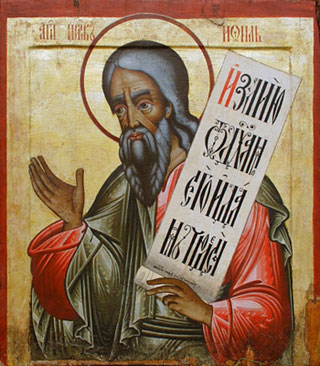
The Holy Prophet Joel lived 800 years before the Birth of Christ. He made prediction
about the desolation of Jerusalem. He likewise prophesied, that upon all flesh
would be poured out the Holy Spirit through the Saviour of the world (Joel 2:
28-32).
Martyr Warus and seven monk-martyrs in Egypt (307)
Commemorated on October 19/November 1
The Holy Martyr Uaros and Seven Teachers of Christians, lived in Egypt during
the period of several persecutions against Christians (late III to early IV Century).
Uaros was a military commander and secretly a Christian. He gave assistance to
many of the persecuted and imprisoned Christians, visiting the prison by night
he brought food to the prisoners, he dressed up wounds, and gave encouragement.
One time he conversed the whole night through with seven
Christian teachers condemned to death, who before had been beaten and held in
starvation. In the morning, when they led the condemned to execution, Uaros marched
together with them. The judge, seeing the particularly strong faith of Uaros,
gave orders to subject him to fierce beatings, during the time of which the holy
martyr died. The Christian teachers were then beheaded. This occurred in the
year 307.
St. Prochorus, miracle-worker of Pchinja (Serbia) (10th c.)
Commemorated on October 19/November 1
St. Prochorus was a contemporary and friend of Saints John of Rila and Gabriel
of Lesnov. According to his prayer, God showed him the place where he would live
a life of asceticism. This place was a wooded area near the River Pchinja. Here
Prochorus labored in asceticism to his old age and repose. Only the One All-seeing
God knows the extent of Prochorus's labors and the temptations he endured in
the course of his asceticism. But one can judge by his myrrh-gushing relics and
his numberless miraculous healings-which have continued up to today-the greatness
of his asceticism and the greatness of God's grace which was given to him because
of his great labors. St. Prochorus entered into rest and took up his abode in
the Kingdom of God in the eleventh century.
Great-martyr Artemius at Antioch (362)
Commemorated on October 20/November 2
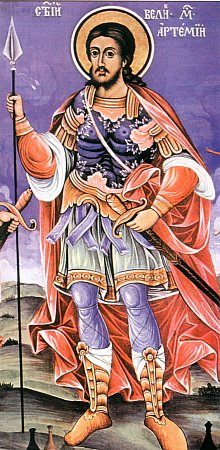
The Holy GreatMartyr Artemios was a prominent military leader
during the reign of the Equal-to-the-Apostles emperor Constantine the Great (306-337,
Comm. 21 May), and later –also of his son and successor Constantius (337-361).
Artemios held many awards for distinguished service and courage, and he was appointed
viceroy of Egypt. In this official position he did much for spreading and strengthening
Christianity in Egypt. The emperor Constantius was succeeded on the throne by
Julian the Apostate (361-363). Julian in his desire to restore paganism carried
on an implacable struggle with Christianity, sending hundreds to their death.At
Antioch he ordered the torture of two bishops unwilling to forsake the Christian
faith. During this time Saint Artemios arrived in the city and publicly denounced
Julian for his impiety. The enraged Julian subjected the saint to terrible tortures,
after which they threw the Great-martyr Artemios into prison. During the time
of prayer which the saint offered to the Lord, Christ Himself appeared to him
surrounded by angels and said: "Take courage, Artemios! I am with thee and
wilt preserve thee from every hurt which the tormentors may inflict upon thee,
and already have I preared thy crown of glory. Wherefore as thou hast confessed
Me before the people on earth, so also shalt I confess thee before Mine Heavenly
Father. Therefore, take courage and rejoice, –thou shalt be with Me in
Mine Kingdom". Hearing this of the Lord Himself, Artemios rejoiced and began
fervently to offer up glory and thanksgiving to Him.
On the following day Julian demanded that the Great-martyr
Artemios honour the pagan gods. Meeting with steadfast refusal, the emperor resorted
to torture. The saint endured all without a single moan. The saint then predicted
to Julian that he would soon receive just recompense for the evil done by him
to Christians. Julian became furious and resorted to even more fiercesome tortures,
but they did not break the will of the saint, and finally the Great-martyr Artemios
was beheaded (+ 362).
His remains were buried by Christians.
And after the death of the holy Great-martyr Artemios, his
prophecy about the impending perishing of Julian the Apostate came true.
Julian left Antioch for a war with the Persians. Near the
Persian city of Ctesiphon he came upon an elderly Persian, who agreed to betray
his countrymen and guide Julian's army. But the old man deceived Julian and led
his army into an impassable place in the Karmanite wilderness, where there was
neither food nor water. Worn down by hunger and thirst, the Graeco-Roman army
of Julian had to do battle against fresh Persian forces.
Divine retribution caught up here with Julian the Apostate.
At the time of battle he was mortally wounded by an unseen hand and an unseen
weapon. Julian groaned deeply, and dying, he said: "Thou hast conquered,
Gallileian!" After the perishing of the apostate-emperor, the relics of
the Great-martyr Artemios were transferred with honour from Antioch to Constantinople.
St. Artemius of Verkola (1545)
Commemorated on October 20/November 2
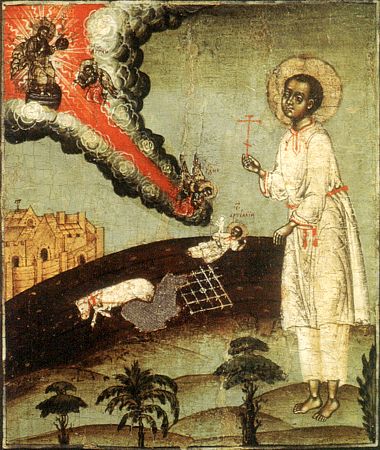
Holy Righteous Artemii of Verkol'sk was born in the village of Dvina Verkol
around the year 1532. The son of pious parents, Artemii was a lad with fortitude,
mildness and diligent for every good deed. On 23 June 1545 the thirteen year
old Artemii and his father were taken by surprise in a field by a thunderstorm.
Under one of the strokes of lightning the lad Artemii fell dead. People thought
that this was a sign of judgement from God, and therefore they left the body
unburied in a pine forest. After 28 days the village clergyman beheld a light
over the place, where the undecayed body of Righteous Artemii lay. Taken to church,
the holy relics were shewn a source of numerous healings. In this village there
was later built a monastery, called the Verkol'sk. The memory of Righteous Artemii
is also celebrated on 22 June.
Venerable Gerasimus the New, ascetic of Cephalonia (1579)
Commemorated on October 20/November 2
The Monk Gerasimos was born in the village of Trikala in the Peloponessus. Upon
reaching maturity he withdrew to the island of Zakina for a monastic life. On
the Holy Mountain he became a schema-monk and studied with the ascetics of Athos.
Having received blessing from the elders, the monk set off to Jerusalem to worship
at the Lifebearing Grave of the Saviour. Having made the rounds of the holy places,
visiting Mount Sinai, Antioch, Damascus, Alexandria and Egypt, he returned to
Jerusalem where he became a a candle-lighter at the Sepulchre of the Lord. The
monk was ordained by the blessed Patriarch of Jerusalem, Germanos (1534-1579),
to the diaconate, and then to the priesthood. The Monk Gerasimos did not slacken
in deeds of prayer. For quietude he withdrew to Jordan, where he spent 40 days
without respite. Having received the Patriarch's blessing for a life of silence,
the monk Gerasimos withdrew Zakinthos. He dwelt there in solitude for 5 years,
nourishing himself on vegetation. At an inspiration from above he went to the
island of Cephalonia and on to Omal, and having restored a church he founded
a women's monastery at which he dwelt for 30 years in constant toil, vigil, and
prayer on bended knee stretched out upon the earth.For his exalted life he was
vouchsafed of God a miraculous gift –to heal the sick and cast out unclean
spirits. The Monk Gerasimos, aware of his impending end for several days, gave
his blessing to the nuns and peacefully expired to the Lord on 15 August 1579,
at 71 years of age. When his grave was opened two years later, his holy relics
were found undecayed and exuding fragrance, and were curative.
The Venerable New Martyr Ignatius
Commemorated on October 20/November 2
Ignatius was from the Bulgarian region of Eski-Zagora. This is that glorious
region of Zagora that has given the Church of God many holy ascetics and martyrs.
He lived a life of asceticism in the Skete of St. John the Forerunner on Mount
Athos. He willingly gave himself to the Turks to be tortured for Christ, and
was hanged in Constantinople on October 8, 1814. His relics are miracle-working,
and his head is honorably preserved in the Monastery of St. Panteleimon on Mount
Athos.
Venerable Hilarion the Great of Palestine (371)
Commemorated on October 21/November 3
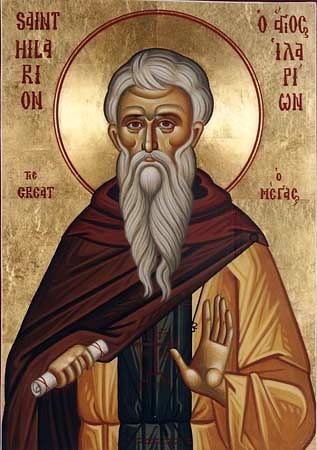
The Monk Ilarion the Great was born in the year 291 in the
Palestinian village of Tabath. He was sent for study to Alexandria, where he
became acquainted with Christianity and accepted holy Baptism. Hearing an account
of the angelic life of the Monk Anthony the Great (Comm. 17 January), Ilarion
set out to him, in order to study that which is pleasing to God. Ilarion soon
returned to his native-land. His parents had already died. Having distributed
his familial inheritance to the poor, Ilarion set out into the wilderness surrounding
he city of Maium. The monk struggled intensely with impure thoughts, vexations
of the mind and the burning of the flesh, defeating them with heavy toil, fasting
and fervent prayer. The devil sought to terrorise the saint with phantoms and
apparitions. During times of prayer Saint Ilarion heard children crying, women
wailing, and the growling of lions and other wild beasts. The monk perceived
that it was the demons causing these terrors, in order to drive him away from
the wilderness, and therefore he overcame his fear with the help of fervent prayer.
One time robbers fell upon the Monk Ilarion, and he by the
power of his words persuaded them to forsake the life of crime.
Soon all Palestine learned about the holy ascetic. The Lord
vouchsafed to the Monk Ilarion the power to cast out unclean spirits. With this
graced gift he loosed the bounds of many of the afflicted. The sick came for
healing, and the monk cured them free of charge, saying, that the grace of God
is not for sale. By means of smell the saint learned with which passion this
or that man was afflicted. And they came to the Monk Ilarion wanting to save
their soul under his guidance. With the blessing of the Monk Ilarion, monasteries
began to spring up throughout all of Palestine. Going from one monastery to another,
he set in them a strict ascetic manner of life. About seven years before his
death (+ 371-372) the Monk Ilarion resettled to Cyprus, where he asceticised
in a solitary place, until the Lord summoned him to Himself.
Translation of the relics (1206) of St. Hilarion, bishop of Meglin, Bulgaria
(1164)
Commemorated on October 21/November 3
The Transfer of the Relics of Sainted Ilarion, Bishop of Meglina, to the Bulgarian
city of Tirnovo, occurred in the year 1206. Prior to this event the body of the
saint rested in the city of Meglina.
Saint Ilarion had received a fine Christian upbringing. In
his 18th year of life he left the world and withdrew to a monastery, which he
was soon chosen to head because of his virtuous and strict life. Concerning himself
over the salvation of the souls entrusted to him, he unceasingly exhorted the
monks not to waste the precious time intended for salvation. With a particular
persistence Ilarion eradicated drunkenness. In the year 1134 he was ordained
bishop of Meglina. At this time the Bogomil heresy was spreading through Bulgaria.
The heretics followed a false teaching, in which good and evil manifest themselves
of independent principles, and between which ensues a struggle. With an apostolic
zeal and fervent prayer Saint Ilarion rose up in struggle against the heretical
pseudo-teaching. He untiringly unmasked the heresy of the Bogomils, snatching
from them their hypocritical guise of piety. In refuting the teaching of the
heretics, Saint Ilarion said: "Ye be not Christians at all, since ye are
hostile to the Cross of Christ the Saviour, ye acknowledge not the One God, ye
slander the ancient Revelation (Old Testament), venerated by Christians. Ye do
deceive simple people by hypocritical meekness, whilst full of pride. True piety
is not possible in those, who see not in themselves corruption of heart, nor
beseech the grace of God by prayer and humility. Evil thoughts, envy, vanity,
greed, lie –are not the deed of some evil thing within man and to be conquered
by mere fasting. These vices –are the fruit of self-love which therefore
demands rooting-out by spiritual efforts".
After the saint's exhortations many of the heretics abandoned
their pseudo-teaching and returned to the bosom of Holy Church. Saint Ilarion
the same way also untiringly and successfully struggled against the rise in Bulgaria
of the Armenian Monophysite heretics, who acknowledged in Christ only the Divine
nature. The saint reposed in the year 1164.
Venerable Philotheus of Neapolis and Mt. Athos (14th c.)
Commemorated on October 21/November 3
The Monk Philotheos of Athos was a native of Elateia. Fearing the Turks, his
parents moved away to Chrysopolis in Macedonia, where soon his father died. The
child Philotheos together with his brother, snatched by the Turks and thrown
into prison, were delivered in a miraculous manner by the Mother of God Herself.
She appeared to the children in the image of their mother and led them to the
monastery of the MostHoly Mother of God in the city of Neapolis in Asia Minor.
At this monastery the brothers accepted monastic tonsure and progressing through
the obediences assigned by the hegumen they attained the position of ecclesiarchs
(church key-holders). Meanwhile the mother of Philotheos, Eudocia, through mysterious
guidance of Divine Providence, had herself settled into a women's monastery in
this selfsame city, and for many years knew absolutely nothing about the fate
of her children. During the time of a temple feastday, being together with several
other nuns at the men's monastery, Eudocia recognised her sons. To her question
as to how they chanced to be there, they answered: "Thou thyself best dost
know, for did not thou, in freeing us from the Turks, lead us hither?" And
thus Eudocia became convinced of the graced intercession of the Mother of God,
in prayers to Whom she alone had found consolation. At this joyous encounter
of the mother and children gathered round all the brethren, and having learned
about the miraculous event, all glorified the Lord. Upon the repose of his mother,
the Monk Philotheos set off to the Holy Mountain, where at first he entered in
with the brethren of the Dionysiatikos monastery, and then withdrew into complete
solitude. Devoting himself to deeds of prayer, the Monk Philotheos attained high
spiritual perfection and was vouchsafed the gift of perspicacity. At the age
of eighty-four the monk peacefully expired to the Lord, having bid his students
not to bury his body, but rather to cast it dishonourably into the forest for
devouring by beasts and birds. His students fulfilled the wish of their monastic
elder, but the Lord glorified he relics of the saint with a wondrous radiance,
after which his relics were returned to the monastery.
Holy Equal-to-the-Apostles Abercius, bishop and wonderworker of Hierapolis (167)
Commemorated on October 22/November 4
The Holy Equal-to-the-Apostles Auerkios the Wonderworker, Bishop of Hieropolis,
was glorified in the II Century in Phrygia. The city of Hieropolis back
then basically was inhabited by pagans. The saint prayed the Lord for the salvation
of their souls and their conversion to the True Light. An Angel appeared and
bid Saint Auerkios to destroy the idols in the pagan temple. With zeal he fulfilled
the command of God. Upon hearing that the idol-worshippers wanted to kill him,
the saint went out to the place where the people had gathered and openly he denounced
the failings of the pagans. The pagans tried to seize hold of the saint. At this
moment in the crowd cried out three demon-possessed youths. The people became
dumbfounded, as the saint by his prayer expelled the devils from them. Seeing
the youths restored to normal, the Hieropolis people besought Saint Auerkios
to instruct them in the Christian faith, and then they accepted Holy Baptism.
After this the saint set off to surrounding cities and villages, healing the
sick and preaching the Kingdom of God. With his preaching he made the rounds
of Syria, Cilicia, Mesopotamia, he visited Rome and everywhere he converted multitudes
of people to Christ. Saint Auerkios because of his great works is termed "Equal-to-the-Apostles".
For many years he guarded the Church against heretics, he affirmed Christians
in the faith, he set the prodigal upon the righteous path, he healed the sick
and propagated the glory of Christ.
Venerable Lot of Egypt (5th c.)
Commemorated on October 22/November 4
Lot was a great Egyptian ascetic and a contemporary of St. Arsenius the Great
and St. Agathon. He lived a life of asceticism in his monastery near a lake at
the town of Arsinoe, and directed many brethren on the path to salvation. His
close friend and advisor was Abba Joseph. Lot once said to Joseph: ``Abba, I
fast as much as I can, hold fast to prayer, keep silence and contemplate, and
also, through abstinence, guard myself from impure thoughts. Therefore, what
else can I do?'' The elder stood up, raised his hands to heaven, and his ten
fingers shone like ten flaming candles. He then replied: ``If you desire, you
can be all aflame!'' Having pleased God and set many on the path to salvation,
St. Lot entered peacefully into rest in the fifth century.
The Kazan Icon of the Most Holy Theotokos, commemorating the deliverance from
the Poles in 1612
Commemorated on October 22/November 4
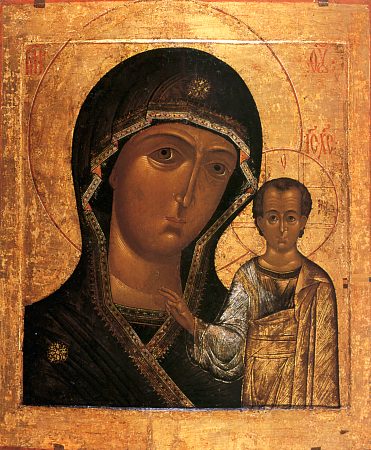
The Celebration of the MostHoly Mother of God, in honour of Her "Kazansk" Icon,
was established in gratitude for the deliverance of Moscow and all Russia from
the incursion of the Polish in 1612. The period of the end of the XVI and beginning
XVII Centuries is known in the history of Russia as "the Time of Troubles" ("Smutnoe
Vremya"). The country suffered the onslaught of Polish armies, which scoffed
at the Orthodox faith, in plundering and burning churches, cities and villages.
By way of deceit they succeeded in taking Moscow. To the appeal of His Holiness
Patriarch Ermogen (Comm. 12 May), the Russian nation rose up in defense of its
native-land. To the militia forces headed by prince Dimitrii Mikhailovich Pozharsky
was sent from Kazan the wonderworking image of the Mother of God.
Sainted Dimitrii of Rostov (Comm. 21 September), in his "Discourse
on the Day of Appearance of the Icon of the Mother of God at Kazan" (Icon
feastday 8 July), said: "The Mother of God doth deliver from misfortune
and woe not only the righteous, but also sinners, but which sinners? Those, which
do turn themselves to the Heavenly Father like the Prodigal Son, they make lamentation
beating their bosom, like the Publican, they weep at the feet of Christ, like
the Sinful Woman washing His feet with her tears, and they offer forth confession
of Him, like the Thief upon the Cross. Upon suchlike sinners is it that the All-Pure
Mother of God doth heed and hasten to their aid, and from great misfortunes and
woe doth deliver".
Knowing that the misfortunes were in sufferance for their
sins, the whole nation and the militia imposed upon themselves a three-day fast
and with prayer they turned to the Lord and His All-Pure Mother for Heavenly
help. The prayer was heard. Situated in captivity under the Polish, from Sainted
Arsenii (afterwards Bishop of Suzdal') came an announcement, that in a vision
to him had been revealed a shifting in the Judgement of God towards mercy, through
the intercession of the MostHoly Virgin. Emboldened by the news, Russian forces
on 22 October 1612 liberated Moscow from the Polish usurpers. Celebration in
honour of the Kazan Icon of the MostHoly Mother of God was established in 1649.
And down to our own day this icon is especially revered by the Russian Orthodox
nation.
Holy Apostle James the Brother of the Lord (63)
Commemorated on October 23/November 5
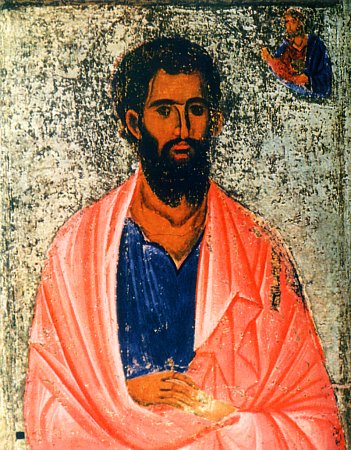
The Apostle James, Brother of the Lord –was the son
of Righteous Joseph the Betrothed (Comm. 26 December). From his early years James
was a Nazorite, a man especially dedicated to God. The Nazorites gave a vow to
preserve virginity, to abstain from wine, to refrain from eating meat, and not
to cut their hair. The vow of the Nazorites symbolised a life of holiness and
purity, commanded formerly by the Lord for all Israel. When the Saviour began
to teach the nation about the Kingdom of God, Saint James believed in Christ
and became His apostle. For his God-leasing life he was chosen first bishop in
the Church at Jerusalem. Saint James presided over the Council of the Apostles
at Jerusalem, and his word was decisive (Acts 15). In his thirty years as bishop
the Apostle James converted many of the Jews to Christianity. Annoyed by this,
the Pharisees and the Scribes plotted together to kill Saint James. Having led
the saint up on the roof of the Jerusalem Temple, they demanded that he renounce
the Saviour of the world. But the holy Apostle James instead began to bear witness,
that Christ is the True Messiah. Then the Jewish teachers shoved him off downwards.
The saint did not die immediately, but gathering his final strength, he prayed
to the Lord for his enemies, who at this while were stoning him. The martyr's
death of Saint James occurred in about the year 63.
The holy Apostle James composed a Divine Liturgy, which has
formed the basis of the liturgies, composed by Saints Bail the Great and John
Chrysostomos. The Church has preserved an Epistle of the Apostle James, which
under his name is included among the books of the New Testament of Holy Scripture.
In the year 1853 the Alexandria Patriarch Hierotheos sent to Moscow a portion
of the relics of the holy Apostle James. The Church makes a distinction between
the holy Apostle James, Brother of the Lord, from James the son of Zebedee (Comm.
30 April) and James Alphaeus (Comm. 9 October).
St. Ignatius, patriarch of Constantinople (877)
Commemorated on October 23/November 5
Ignatius was the son of Emperor Michael Rangabe. He became patriarch after St.
Methodius in 846. Then Ignatius was deposed in 858 and exiled. Photius, the chief
secretary to the emperor, was made patriarch in his place. However, when Emperor
Basil the Macedonian ascended the throne, he re-instated Ignatius to the patriarchal
throne. St. Ignatius governed the Church with great zeal and wisdom. He built
the Monastery of the Holy Archangels in which he reposed in the Lord in the eighty-ninth
year of his life.
Translation of the relics of Blessed James of Borovichi, wonderworker of Novgorod
(1540)
Commemorated on October 23/November 5
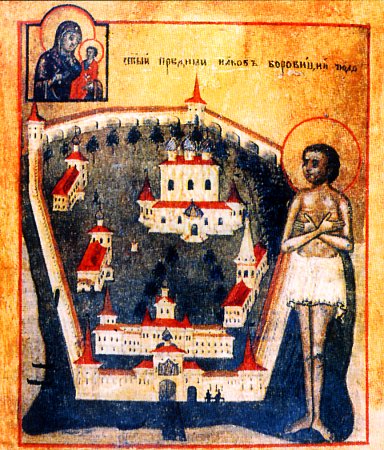
Righteous Iakov (James) Borovich, Novgorod Wonderworker, in his youth took upon
himself the ardous task of fool-for-Christ. Most of the details of his life are
unknown. The Lord glorified him after death. In the year 1540, on the third day
of Pascha, a large block of ice floated up against the current along the River
Msta to the village of Borovich (in Novgorod district), and on this block of
ice stood the coffin (an oaken log) without cover, upon which lay the body of
the youth. Shunning their responsibility, peasants with poles shoved the block
of ice to mid-stream, but it returned to the shore. This was repeated three times.
By night the youth appeared in a dream to the elders of the village, who had
seen him upon the ice-floe, and said: "I too am a Christian just like ye.
Push me not away. My name is Iakov, and I received my name in honour of Saint
Iakov (James), Brother of the Lord".
The relics of the holy lad were at first placed in a chapel,
and in 1544 transferred to the Holy Spirit church. Then was established a festal
celebration to him. The Lord, having glorified his God-pleasing one, granted
the relics of Saint Iakov a curative power. A feastday with matins was established
in 1572. In the Iconographic Originals it says about Saint Iakov: "The likeness
of a lad, bare, girded with a piece of cloth". In 1657 Patriarch Nikon dispatched
part of the relics to Valdai, to the Iversk monastery.
Martyr Arethas of Omir and with him 4299 Martyrs (523)
Commemorated on October 24/November 6
The Martyr Aretha and with him 4299 Martyrs suffered for the Lord Jesus Christ
in the VI Century. Aretha was governor of the city of Negran in Arabia, the inhabitants
of which were Christian. The Arabian (or Omirite) king, Dunaan, who was Jewish,
decided to extirpate Christianity from the land, and he issued an edict that
all followers of Christ were to be put to death. The inhabitants of Negran remained
faithful to the Lord, and Dunaan came with a large army to destroy the city.
At the city-walls of Negran the king's heralds announced, that Dunaan would let
live only those who renounced the Crucified Galileian and His Cross, as a "sign
of malediction". Not daring to assault the Christian city by force, Dunaan
resorted to a ruse, swearing an oath that he would not force the Christians into
Judaism, but would merely impose a tribute-tax on Negran. The inhabitants of
the city would not heed the advice of Saint Aretha [his name in Greek means "virtue",
as if here literally to suggest that the people "would not heed the voice
of virtue"], and putting their trust in Dunaan, they opened wide the city-gates.
The very next day Dunaan gave orders to start up an immense
bon-fire and throw in it all the clergy of the Church of the city, so as to frighten
all the rest of the Christians. Thus were burnt 427 men. The governor Aretha
and the other chief men were thrown into prison. Then the oppressor sent out
through the city his messengers, to convert the Christians to Judaism. And Dunaan
himself conversed with those inhabitants brought forth from the prisons, saying: "I
do not demand of you that ye should renounce the God of heaven and earth, nor
do I want that ye should worship idols, but I want merely that ye do not believe
in Jesus Christ, since the Crucified One was a man, and not God". The holy
martyrs replied to this, that Jesus –is God the Word, the Second Person
of the Holy Trinity, Who for the salvation of mankind had become flesh from the
Holy Spirit and the Virgin Mary. "We shalt not abjure Christ, since that
He is for us –Life, and death for Him –is the finding of Life", –declared
the sufferers to Dunaan. And more than four thousand Christians –men, women,
both the aged and children –from the city of Negran and surrounding villages
accepted a martyr's death for Christ.
Saint Elesbaan, King of Ethiopia (553)
Commemorated on October 24/November 6
Blessed Elezboi, Emperor of Ethiopia, lived during the time when Arabia was ruled
by the oppressor of Christians, Dunaan. Pious Elezboi was unable to look on indifferently
as believers in Christ were being massacred, and he declared war on Dunaan. But
his military campaign was unsuccessful. Wanting to learn the reason for his defeat,
Elezboi at the prompting from above turned to a certain hermit, who revealed
to the emperor, that he had proceeded unrighteously in deciding to take revenge
against Dunaan, since the Lord had said: "Vengeance is Mine, and I shalt
mete it forth!" (Heb. 10: 30). The hermit counselled Blessed Elezboi to
devote his final days of life to God, so as to flee the wrath of God for his
self-willed revenge, and then to defeat Dunaan. Saint Elezboi made a vow to the
Lord, and having set off with his army against the enemy, he defeated and captured
and executed him. After the victory the saint resigned as emperor, secluded himself
within a monastery and for 15 years he dwelt in strict fast and ascetic deeds
(+ c. 553-555).
Icon of the Most Holy Theotokos "The Joy of All Who Sorrow" (1688)
Commemorated on October 24/November 6
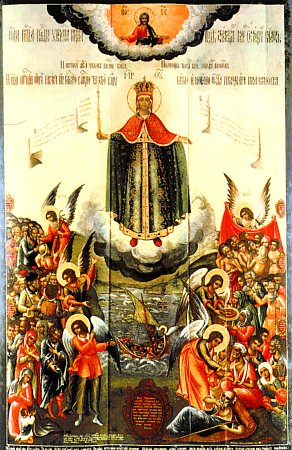
The Icon of the Mother of God "Joy of All Who Sorrow" was glorified
by wonderworking in the year 1688. A sister by birth of patriarch Joakim (1674-1690),
Evphymia, who lived at Moscow, for a long time suffered from an incurable illness.
One morning during a time of prayer she heard a voice: "Evphymia! Go thou
to the temple of the Transfiguration of My Son; an image is there, named "Joy
of All Who Sorrow". Have the priest serve a molieben with a blessing of
water, and thou wilt receive healing from sickness". Evphymia, having learned
that in Moscow was actually such an icon in the church of the Transfiguration
on Ordynka, did the bidding of the MostHoly Mother of God, and she was healed.
This occurred on 24 October 1688. The account about the icon of the Mother of
God "Joy of All Who Sorrow" (with its petty change welded by a bolt
of lightning), manifest at Peterburg in 1888, is to be found under 23 July.
Venerables Aretha (12th C), Sisois (13th C) and Theophil (12th-13th C), Hermits
of the Kievan Caves, near caves
Commemorated on October 24/November 6
The Monks Aretha, Sisoi and Theophil, Hermits of Pechersk (XII-XIII), pursued
asceticism at the Kievo-Pechersk monastery and were buried in the Nearer Caves.
The Monk Aretha was from Polotsk. While living at the monastery,
he kept in his cell much wealth. One time robbers made off with it. Grieving
over his lost riches, the Monk Aretha began to murmur against God, for which
he was stricken with a serious illness. Being at the very brink of death, he
saw, how both Angels and devils had come for him and were arguing between them.
The devils asserted, that for his avarice and complaints against God he ought
to be given over to them, while the Angels in turning to him bewailed: "Thou
hapless man, if thou had given thanks to God for the pilfered riches, this would
have been accounted in charity for thee". After this vision the Monk Aretha
was restored to life. His final days he spent as an hermit, in distress and repentance
over his sins, having renounced everything earthly. Saint Aretha died not later
than the year 1190. In the Iconographic Originals, the monk is described thus: "In
appearance stooped over, beard in length of some Kozmina, monastic robes".
The Monk Sisoi, an hermit, in the general service to the
Monks of the Antoniev Caves is called "radiant in fasting".
The Monk Theophil in the same service is called "in
miracles resplendid".
The commemoration of all the monks is also on 28 September
and on the 2nd Sunday of Great Lent.
Martyrs Marcian and Martyrius the Notaries of Constantinople (355)
Commemorated on October 25/November 7
The Holy Martyrs Marcian and Martyrios served in a Constantinople cathedral.
Marcian was a reader, and Martyrios a sub-deacon. They both likewise performed
duty in the capacity of notaries, i.e. secretaries, for the Patriarch Paul the
Confessor (Comm. 6 November).
Arian heretics expelled and secretly executed the righteous
Patriarch Paul, and his cathedra-chair was given over to the heretic Macedonios.
The heretics attempted to entice Saints Marcian and Martyrios over to their side
by flattery, they offered them gold and promised them cathedra-chairs as archbishops.
But all the Arian efforts were in vain.
Then the impious threatened to slander them before the emperor,
and sought to intimidate them with torture and death. But the saints steadfastly
confessed Orthodoxy, as handed down by the fathers of the Church. Marcian and
Martyrios were sentenced to death. Before death, the martyrs raised up to the
Lord a fervent prayer: "Lord God, Who hath invisibly created our hearts,
and directed all our deeds, accept with peace the souls of Thy servants, since
we do perish for Thee and art considered as sheep for the slaughter (Ps. 32 [33]:
15; 43 [44]: 23). We do rejoice, that by such a death we shalt depart this life
for Thy Name. Grant us to be partakers of life eternal with Thee, the Source
of life". After their prayer, the martyrs with quiet rejoicing bent their
necks beneathe the sword of the impious (+ c. 335). Their holy bodies were reverently
buried by Orthodox Christians. Later on, by decree of the holy Bishop John Chrysostom,
the relics of the holy martyrs were transferred into an especially built church.
Believers here were healed of many infirmities through the prayers of the saints,
to the glory of the One Life-Originating Trinity.
Martyr Anastasius the Fuller at Salona in Dalmatia (3rd c.)
Commemorated on October 25/November 7
The Holy Martyr Anastasius lived during the III Century in the city of Aquileia
(northern Italy). Because of his missionary activity in the city of Salona (Dalmatia),
he was arrested and brought to trial. Boldly and without wavering, the Martyr
Anastasius confessed Christ as the True God and Creator of all. By the decision
of the court he was sentenced to death by execution. The pagans threw the body
of Saint Anastasius into the sea. A righteous Christian, the rich matron Ascalopia,
found the body of the Martyr Anastasius and reverently buried him in her estate
church. The relics of the holy martyr were glorified by many miracles.
St. Tabitha, the widow raised from the dead by the Apostle Peter (1st c.)
Commemorated on October 25/November 7
St. Tabitha (which means ``gazelle'') was a disciple of the apostles and lived
in Joppa. She was full of good works and almsdeeds (Acts 9:36), but suddenly
became weak and died. The Apostle Peter was then in the town of Lydda, and the
grieving disciples sent for him, imploring him to comfort her kinsmen. Upon his
arrival, the great Apostle of Christ told everyone to leave the room where the
corpse lay, then knelt in prayer. Then, turning to the body, he said: Tabitha,
arise (Acts 9:40) and Tabitha opened her eyes and stood up. Many believed in
the Lord Jesus Christ because of this wonderful miracle.
Holy and Glorious Great-martyr Demetrius the Myrrh-gusher of Thessalonica (306)
Commemorated on October 26/November 8
This glorious and wonderworking saint was born in Thessalonica of noble and devout
parents. Implored of God by childless parents, Demetrius was their only son,
and so was raised and educated with great care. Demetrius's father was a commander
in Thessalonica. When his father died, Emperor Maximian appointed Demetrius as
commander in his place. As he appointed him, Maximian, an opponent of Christ,
particularly recommended that he persecute and exterminate the Christians in
Thessalonica. Demetrius not only disobeyed the emperor but openly confessed and
preached the Lord Jesus Christ in the city of Thessalonica. When the emperor
heard of this he became furious with Demetrius. Then, when he was returning from
battle against the Sarmatians, Maximian stopped at Thessalonica to investigate
the matter. The emperor summoned Demetrius and questioned him about his faith.
Demetrius openly acknowledged his Christian Faith to the emperor and also denounced
the emperor's idolatry. Maximian cast Demetrius into prison. Knowing what was
awaiting him, Demetrius gave all his goods to his faithful servant Lupus to distribute
to the poor, and joyfully awaited his imminent suffering for Christ the Lord.
An angel of God appeared to him in prison, saying: ``Peace be to you, O sufferer
of Christ; be brave and be strong!'' After several days, the emperor sent soldiers
to the prison to kill Demetrius. The soldiers found the saint of God at prayer
and ran him through with lances. Christians secretly took his body and honorably
buried it. Healing myrrh flowed from the body of the martyr of Christ, curing
many of the sick. Soon, a small church was built over his relics.
An Illyrian nobleman, Leontius, was afflicted with an incurable illness. He hastened,
with prayer, to the relics of St. Demetrius and was completely healed. In thanksgiving,
Leontius erected a much larger church on the site of the old church. The saint
appeared to him on two occasions. When Emperor Justinian wanted to translate
the relics of the saint from Thessalonica to Constantinople, flaming sparks sprang
from the tomb and a voice was heard: ``Stop, and do not touch!'' And thus, the
relics of St. Demetrius have remained for all time in Thessalonica. As the protector
of Thessalonica, St. Demetrius has appeared many times, and on many occasions
has saved Thessalonica from great calamity. His miracles are without number.
The Russians considered St. Demetrius to be the protector of Siberia, which was
conquered and annexed to Russia on October 26, 1581.
The Venerable Martyr Ioasaph
Commemorated on October 26/November 8
Ioasaph was a disciple of St. Niphon, Patriarch of Constantinople, and labored
in asceticism on the Holy Mountain. He had so great a love for Christ that all
of his ascetic works seemed inadequate, and from love he desired to suffer for
his Lord. For that reason he went to Constantinople, where he openly confessed
to the Turks his faith in the Holy Trinity and the Son of God. The enraged Turks
beheaded him on October 26, 1536.
Commemoration of the Great Earthquake at Constantinople in 740 A.D.
Commemorated on October 26/November 8
In the year 740, during the reign of Emperor Leo the Isaurian, there was a terrifying
and prolonged earthquake in Constantinople. The people considered this a punishment
from God for their sins, and prayed with great repentance to the Most-holy Theotokos
and St. Demetrius, until God showed mercy and the earthquake ceased.
Martyr Nestor of Thessalonica (306)
Commemorated on October 27/November 9
In the time of the suffering of St. Demetrius the Myrrh-gusher, there was a young
man of Thessalonica, Nestor, who learned the Christian Faith from St. Demetrius
himself. At that time Christ's enemy, Emperor Maximian, organized various games
and amusements for the people. The emperor's favorite in these games was a Vandal
by the name of Lyaeus, a man of Goliath-like size and strength. As the emperor's
gladiator, Lyaeus challenged men every day to single combat and slew them. Thus,
the bloodthirsty Lyaeus amused the bloodthirsty, idolatrous Maximian. The emperor
built a special stage for Lyaeus's battles, similar to a threshing floor on pillars.
Spears, points upward, were planted beneath this platform. When Lyaeus defeated
someone in wrestling, he would throw him from the platform onto the forest of
spears. The emperor and his pagan subjects cheered as some poor wretch writhed
in torment on the spears until he died. Among Lyaeus's innocent victims were
many Christians: when no one volunteered to duel with Lyaeus, by the emperor's
orders Christians were arrested and forced to duel with him. Seeing this horrifying
amusement of the pagan world, Nestor's heart was torn with pain, and he decided
to come forward for a duel with the gigantic Lyaeus. But first, he went to prison
to see St. Demetrius and sought a blessing from him to do this. St. Demetrius
blessed him, signed him with the sign of the Cross on the forehead and on the
chest and prophesied to him: ``You will defeat Lyaeus, but you will suffer for
Christ.'' Thus, young Nestor went to duel with Lyaeus. Maximian was present with
a multitude of people; everyone felt pity for the young Nestor, who would surely
die, and tried to dissuade him from dueling with Lyaeus. Nestor crossed himself
and said: ``O God of Demetrius, help me!'' and with God's help, he overcame Lyaeus,
knocked him down, and threw him onto the sharp spears, where the heavy giant
soon found death. Then all the people cried out: ``Great is the God of Demetrius!''
But the emperor, shamed before the people and sorrowing for his favorite Lyaeus,
was greatly angered at Nestor and Demetrius, and commanded that Nestor be beheaded
and Demetrius run through with lances. Thus, the Christian hero Nestor ended
his earthly life and took up his habitation in the Kingdom of his Lord in the
year 306.
Venerable Nestor the Chronicler of the Kiev Caves (1114)
Commemorated on October 27/November 9
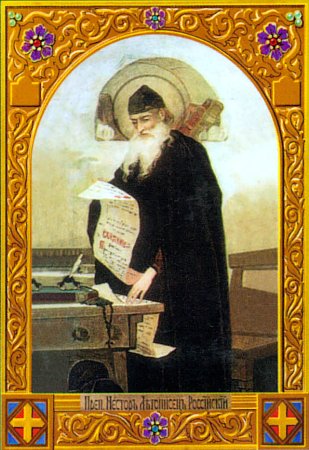
At the age of seventeen, Nestor entered the Monastery of the Kiev Caves while
St. Theodosius was still abbot. He wrote the first history of the Russian people,
in which he intertwined the history of Russian asceticism. He was distinguished
by unusual humility and meekness. In his literary work, he often referred to
himself as unworthy, coarse, ignorant and full of every kind of sin. But God,
Who knows the hearts of men, glorified this wonderful saint of His. When Nestor
entered into rest on October 27, 1114, his relics performed many miracles.
Uncovering of the relics (1539) of St. Andrew, prince of Smolensk (1390)
Commemorated on October 27/November 9
The Uncovering of the Relics of the Holy Nobleborn Prince Andrei of Smolensk
occurred in the year 1539 through the involvement of the Monk Daniel of Pereslavl'
(+ 1540, Comm. 7 April).
The holy nobleborn Prince Andrei was son of the Smolensk
prince Feodor Fominsky. While still in his youthful years he was grieved by the
disputes of his brothers, and he left his native city going as a simple wanderer
to Pereslavl' Zalessk. In humility and meekness he spent thirty years as church
warden at the church of Saint Nicholas, also nearby which he is buried. After
his death they discovered an heirloom princely ring, a gold chain and an inscription
with the words: "I am Andrei, one of the Smolensk princes".
Great-martyr Parasceva of Iconium (3rd c.)
Commemorated on October 28/November 10
She was born in the city of Iconium of wealthy and Christ-loving parents. After
the death of her parents, the maiden Parasceva began to distribute her possessions
to the poor and the less fortunate, all in the name of Christ the Lord. When
a persecution began under Diocletian, Parasceva was brought to trial before the
governor of that land. When the governor asked her for her name, she replied
that she was called a Christian. The governor rebuked her because she did not
give her usual name and Parasceva said to him: ``First, I had to tell you my
name in eternal life, and then my name in this temporal life.'' After flogging
her, the governor cast Parasceva into prison where an angel of God appeared to
her, healed her of her wounds, and comforted her. By prayer, Parasceva destroyed
all the idols in the pagan temple. After prolonged and harsh tortures, Parasceva
was beheaded with the sword and took up her abode in eternal life.
St. Arsenius I of Srem, archbishop of Serbia (1266)
Commemorated on October 28/November 10
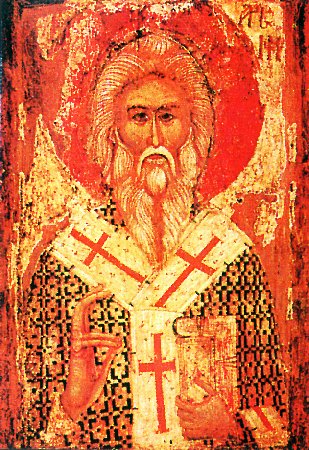
Sainted Arsenii, Archbishop of Serbia, spent a large part of his life as a monk
at the Zhich monastery. Because of his strict ascetic life, in 1223 he was ordained
Archbishop of Serbia. After thirty-three years of wisely guiding his flock Saint
Arsenii expired to the Lord in the year 1266. His relics rest at the Pech monastery.
Martyrs Terence and Neonilla of Syria, and their children Sarbelus, Photus, Theodulus,
Hierax, Nitus, Bele, and Eunice (249)
Commemorated on October 28/November 10
The Holy Martyrs Terence and Neonilla and their children: Sarbilus, Fotus, Theodulus,
Hierax, Nitus, Vilus and Eunicius suffered a martyr's end during a persecution
of Christianity under the emperor Decius (249-250). They zealously confessed
Christ and denounced idolatry. For this the pagans subjected the entire Christian
family to terrible tortures and torments, but failed to get them to renounce
the true faith. The holy martyrs finally were beheaded.
Venerable Stephen of St. Sabbas monastery, hymnographer (807)
Commemorated on October 28/November 10
The Monk Stephanos Savvaites, nephew of Saint John of Damascus (Comm. on 4 December),
was born in the year 725. The ten year old lad entered the Lavra of Saint Savva
and spent his whole life at this monastery, sometimes going out into the wilderness
for solitary ascetic deeds. The monk Stephanos was bestowed the gifts of wonder-working
and perspicacity: he healed the sick, cast out devils, and discerned the thoughts
of those coming to him for counsel. He died in the year 724, foretelling in advance
the day of his death. The life of the monk was compiled by his student Leontios.
Saint Athanasius, Patriarch of Constantinople
Commemorated on October 28/November 10
He was an opponent of union with Rome, in contrast to his predecessor John Beccus
(1275-1282). He was an ascetic and a prayerful person from his childhood. Beloved
by his people, Athanasius provoked the displeasure of certain priests by his
moral strictness. He withdrew to his monastery on Mount Ganos, where he labored
even more austerely than before. The Lord Jesus Christ Himself appeared to him
and scolded him gently for leaving his flock to the wolves. When he foretold
the day of the earthquake in Constantinople, Emperor Andronicus reinstated him
to the patriarchal throne against his will. After that, he again secretly withdrew
to the ascetic life. He entered into rest at the age of one hundred. He was clairvoyant
and a miracle-worker.
St. Demetrius, metropolitan of Rostov (1709)
Commemorated on October 28/November 10
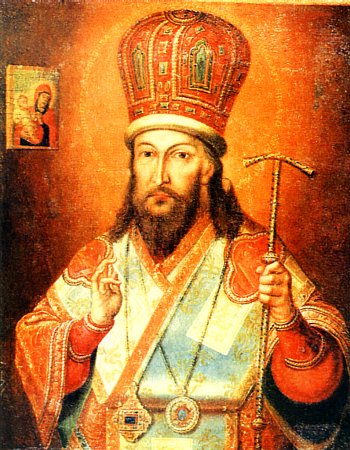
Dimitri was a great hierarch, preacher, author and ascetic. He was born near
Kiev in the year 1651, and reposed in the year 1709. Among his many glorious
works of instruction, he was known especially for his translation and publication
of The Lives of the Saints. He foresaw his own death three days in advance, and
died while at prayer. Dimitri was a great light of the Russian Church and of
Orthodoxy in general. He had heavenly visions during his life. He served the
Lord zealously and took up his habitation in the Kingdom of Heaven.
Virgin-martyr Anastasia the Roman (256)
Commemorated on October 29/November 11
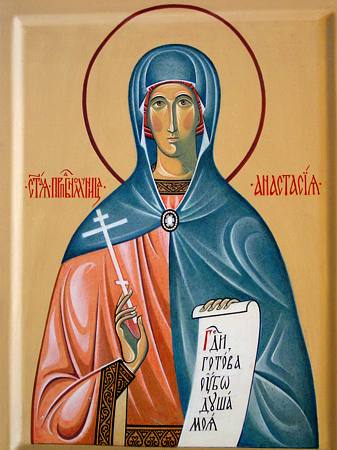
The MonasticMartyress Anastasia the Roman in infancy lost
her parents, and she was then taken under the care of the head of a women's monastery,
named Sophia. The hegumeness raised Anastasia in fervent faith, in the fear of
God and obedience. During these times there began the persecution against Christians
by the emperor Decius (249-251). The city administrator, Probus, on the orders
of the emperor commanded that Anastasia be brought to him. Having been blessed
by her eldress-mentor for the deed of suffering for the Name of Christ, the young
Martyress Anastasia humbly came out to meet the armed soldiers. Seeing her youth
and beauty, Probus at first attempted by false flattery to tempt her and lead
her into a renunciation of faith in Christ: "Why waste thine years, deprived
of pleasure? What is there to gain in giving thyself over to tortures and death
for the Crucified? Worship our gods, get thyself some handsome husband, and live
in glory and honour". The saint steadfastly replied: "My Bridegroom,
my riches, my life and my happiness –is my Lord Jesus Christ, and with
the threat of torments thou canst not part me from the Lord!" Fiercesome
tortures were then begun. The holy martyress bravely endured them, glorifying
and praising the Lord. In anger the torturers cut out her tongue. The people,
seeing the inhuman and disgusting treatment of the saint, became indignant, and
the governor of the city was compelled to bring the torture to a close, by beheading
the martyress. The body of Saint Anastasia was thrown out beyond the city for
devouring by wild animals, but the Lord did not permit that a mockery should
be made with the holy remains. Learning of this through the Lord, the hegumeness
Sophia found the torn body of the martyress, and with the help of two Christians
she consigned it to earth.
Venerable Abramius the Recluse (360) and his niece St. Mary, of Mesopotamia (397)
Commemorated on October 29/November 11
The Monk Abraham the Hermit and Blessed Maria, his niece, asceticised in the
village of Chidan, near the city of Edessa. They were contemporaries and of the
same country together with the Monk Ephrem the Syrian (Comm. 28 January), who
afterwards wrote about their life. The Monk Abraham began his difficult exploit
of the solitary life in the prime of youth. He left his parental home and settled
in a desolate wilderness place, far off from worldly enticements, and he spent
his days in unceasing prayer. After the death of his parents, the saint refused
his inheritance and requested his kinsmen to give it away to the poor. By his
strict ascetic life, fasting and love for mankind, Abraham attracted to him many,
seeking after spiritual light, prayer and blessing. Soon his faith was put to
a serious test: he was appointed presbyter in one of the pagan villages of Mesopotamia.
For three years, and sparing no efforts, the monk toiled over the enlightenment
of the pagans. He tore down a pagan temple and built up a temple of God. Humbly
enduring derision and even beating from obstinate idol-worshippers, in prayer
he beseeched the Lord: "Look down, O Master, upon Thine servant, hearken
unto my prayer, strengthen me and set free Thy servants from diabolical snares
and grant them to know Thee, the One True God". The zealous pastor was granted
the happiness to see the culmination of his righteous efforts: the pagans came
to believe in Jesus Christ, the Son of God, and the monk himself baptised them.
Having fulfilled his priestly duty, Abraham again withdrew into his wilderness,
where he continued to glorify God, and doing His holy will. The devil, put to
shame by the deeds of the monk, tried to entrap him with proud thoughts. One
time at midnight, when Saint Abraham was at prayer in his cell, suddenly there
shone a light and a voice was heard: "Blessed art thou, blessed as is no
one amongst mankind!" Confuting the wiles of the enemy, the saint said: "I –am
a sinful man, but I trust on the help and grace of my God and I fear thee not".
Another time the devil appeared before the saint in the form of a youth, lighted
a candle and began to sing the Psalm: "Blessed is the undefiled on the way
that walketh in the law of the Lord". Perceiving, that this also was a demonic
temptation, the elder crossed himself and asked: "If thou knowest, what
be the undefiled blessed, then why troublest thou them?" The temptor answered: "I
provoke them in order to conquer them and turn them away from every good deed".
To this the saint replied: "Thou gainest victory over those fallen away
from God through their will, but for those loving God thou dost vanish, like
smoke in the wind". After these words the devil vanished. And thus did Saint
Abraham defeat the enemy, strengthened by Divine grace. After fifty years of
ascetic life he peacefully expired to the Lord (+ c. 360).
The Venerable Martyr Timothy of Esphigmenou
Commemorated on October 29/November 11
He was from the village of Kessana in Thrace. He was married and had two daughters.
His wife was seized by the Turks and became a Moslem. In order to save his wife
from the harem, he pretended to become a Moslem. After rescuing his wife, he
conducted her to a convent, while he went to the Great Lavra on Mount Athos and
then to the Monastery of Esphigmenou. He desired martyrdom for Christ, like Agathangelus
of Esphigmenou, and was beheaded in Jedrene on October 29, 1820. His body was
thrown into a river, but his clothing was retrieved by Elder Germanus, the spiritual
father of Esphigmenou.
Hieromartyr Zenobius and his sister Zenobia of Aegae, Cilicia (285)
Commemorated on October 30/November 12
The PriestMartyr Zenobios, Bishop of Egeia, and his sister Zenobia suffered a
martyr's death in the year 285 in Cilicia. From childhood they were raised in
the holy Christian faith by their parents, and they led pious and chaste lives.
In their mature years, shunning the love of money, they distributed away their
wealth, an inheritance, giving it to the poor. For his beneficence and holy life
the Lord rewarded Zenobios with the gift of healing various maladies. And he
was chosen bishop of a Christian community in Cilicia.
In the dignity of bishop, Saint Zenobios zealously spread
the Christian faith among the pagans. When the emperor Diocletian (284-305) began
a persecution against Christians, Bishop Zenobios was the first one arrested
and brought to trial to the governor Licius. "I shalt speak with thee but
briefly, –said Licius to the saint, –for I propose to thee: life –if
thou worshipest our gods, or death –if thou dost not". The saint answered: "This
present life without Christ is death; better I prepare to endure the present
torment for my Creator, and then with Him live eternally, than to renounce Him
because of the present life, and then be tormented eternally in hades".
By order of Licius, they nailed him to a cross and began
the torture. The sister of the bishop, seeing the suffering of her brother, wanted
then to stop it with him. She bravely confessed her own faith in Christ afront
the governor, for which she also was given over to torture.
By the power of the Lord they remained alive after torture
on a red-hot cot and in a boiling kettle. The saints were then beheaded. Presbyter
Hermogenes secretly buried the bodies of the martyrs.
The Holy Apostles Cleopas, Tertius, Mark, Justus and Artemas
Commemorated on October 30/November 12
They were all numbered among the Seventy. The risen Lord appeared to Cleopas
on the road to Emmaus (Luke 24:13-33). Tertius wrote down the Epistle to the
Romans for Paul (Romans 16:22), and died a martyr as Bishop of Iconium after
the Apostle Sosipater (November 10). St. Mark (or John) was the son of the devout
Mary (whose home was a refuge for the apostles and the first Christians), and
a kinsman of Barnabas (Acts 12:12). He became the bishop of the Samaritan town
of Apollonia. Justus was a son of Joseph the Betrothed. Together with Matthias,
he was one of those selected as a possible replacement for Judas the traitor,
but he was not chosen. He suffered for the Gospel as a bishop in Eleutheropolis.
St. Artemas was Bishop of Lystra in Lycaonia, and reposed peacefully.
St. Stephen Milutin (1320), his brother St. Dragutin (monk Theoctistus) (1316),
and their mother St. Helen (1306), wife of Urosh I of Serbia
Commemorated on October 30/November 12
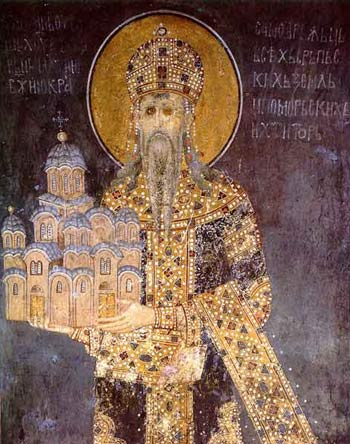
Saint Stefan (Stephen) Miliutin, King of Serbia, his brother Dragutin, and their
mother Elena (Helen): Saint Stefan was the younger son of king Stefan Urosh I,
and grandson of First-Crowned King Saint Stefan (Comm. 24 September). He ruled
Serbia from 1275 to 1320. Stefan Miliutin received the throne from his elder
brother Dragutin, a true Christian, who after a short reign transferred power
over to his brother, and he himself in loving solitude withdrew to Srem, where
he did secret ascetic deeds in a grave-pit, dug by his own hand. During his righteous
life, Saint Dragutin toiled much over converting the heretic Bogomils to the
true faith. His death occurred on 2 March 1316.
Saint Stefan Miliutin, having become king, bravely by both
word and by deed, defended the Orthodox Serbs and other same-faith peoples from
numerous enemies. Pious Stefan did not forget to thank the Lord for His beneficence.
More than 40 churches were built by him, as also many monastery and vagrant hostels.
The saint particularly concerned himself with the Athonite monasteries.
When the Serbian kingdom fell, the monasteries remained centres
of national culture and Orthodoxy for the Serb nation. Saint Stefan died on 29
October 1320 and was buried at the Bansk monastery. After two years his undecayed
relics were uncovered.
Saint Elena, the pious mother to her sainted sons, after
the death of her husband devoted her whole life to pious deeds: she built a shelter
for the impoverished, and constructed a monastery for those wanting to live in
purity and virginity. Near the city of Spich she erected the Rechesk monastery
and endowed it with the necessities. Before her death, Saint Elena accepted monasticism
and expired to the Lord on 8 February 1306.
Apostles Stachys, Amplias, Urban, Narcissus, Apelles, and Aristobulus of the
Seventy (1st c.)
Commemorated on October 31/November 13
The Holy Disciples from the Seventy –Stakhios, Amplias, Urban, Narcissos,
Apellias and Aristoboulos (I): The holy Apostle Andrew the First-Called ordained
Stakhias to the dignity of bishop of Byzantium, where he was bishop for sixteen
years, zealously preaching the Gospel of Christ and converting pagans to the
true faith. Saint Amplias was bishop in the city of Diospolis; Saint Urban –in
Macedonia. They also were bishops by the consecration of the holy Apostle Andrew.
For preaching the Gospel they were put to a martyr's death by Jews and pagan
Greeks. Saint Narcissos was bishop in the city of Athens. Saint Apellias was
bishop at Heraclium. About Saint Aristoboulos the account is situated under 16
March.
Martyr Epimachus of Pelusium, who suffered at Alexandria (250)
Commemorated on October 31/November 13
He was born in Egypt and labored there in asceticism, ending his earthly life
as a martyr. Imitating St. John the Baptist, he withdrew to the wilderness while
still a youth. Because of his great love for God, the Spirit of God led him to
every truth and, with no other teacher, taught him how to live a life of asceticism.
Then, Epimachus learned that the unbelievers were torturing and killing Christians
in Alexandria for the sake of Christ. All aflame with zeal for the Faith, he
went to the city and smashed the idols. When the pagans tortured him for this,
he cried out: ``Smite me, spit on me, put a crown of thorns on my head, put a
reed in my hand, give me gall to drink, crucify me on a cross, and pierce me
with a spear! This is what my Lord endured, and I too want to endure it.'' In
the crowd of people who witnessed the torturing of St. Epimachus, there was a
woman who was blind in one eye. She wept bitterly, watching the heartless torture
of this God-pleaser. When the tormentors scraped the body of the holy martyr
of Christ, blood spurted from him, and one drop of blood touched the blind eye
of that woman. Suddenly, her blind eye regained vision, and was as whole as the
other. Then she cried out: ``Great is the God in whom this sufferer believes!''
After this they beheaded St. Epimachus and his soul took up habitation in eternal
joy, in about the year 250.
New Martyr Nicholas the New of Chios (1754)
Commemorated on October 31/November 13
Raised in piety, he worked as a stone-mason until an accident deprived him of
his reason and of the power of speech. The local Turkish rulers took advantage
of his condition to declare him a Muslim. For years thereafter he was employed
as a shepherd until he met a monk named Cyril, who prayed fervently that he be
restored to his senses. He was miraculously restored, and almost immediately
was filled with the desire to repent and to live only for Christ, devoting himself
to prayer, fasting and vigil. Some time later he was falsely suspected of a crime
by the (Christian) people of his village, and brought before the Turkish authorities.
When he was questioned, he declared 'I was born a Christian, I was brought up
as a Christian, I have never denied Christ for Islam, and I never will deny Him,
but will die a Christian.' For this he was brutally tortured. Many local Christians,
including the village priest, feared for their own safety and urged him to deny
Christ, but Nicholas only rebuked them and stood firm. After many days of torture
he was finally slain by the sword. The Synaxarion tells how a thick darkness
fell on the whole island of Chios. When the dismayed Turks burned the Martyr's
body to be rid of this miracle, they were further dismayed when a heavenly scent
rose from the flames, revealing the Saint's entry into eternal glory.
Venerables Spyridon and Nicodemus the Prosphorabakers of the Kiev Caves (1148)
Commemorated on October 31/November 13
The Monks Spiridon and Nikodim, Prosphora-Makers of Pechersk (XII), for 30 years
fulfilled their obedience –they baked prophora. The Monk Spiridon came
to the monastery during the time of the hegumen Pimen (1132-1141), already no
longer young a man. The ascetic combined his work with unceasing prayer and the
singing of psalms. Even during his life the Monk Spiridon was glorified by miracles.
An instance is known, when he extinguished his mantle which had caught fire from
the oven –the fire was put out, but the mantle remained whole. Saint Nikodim
toiled together with the Monk Spiridon and led a very strict life. Their relics
are located in the Antoniev Cave. The fingers of the right hand of the Monk Spiridon
are positioned together three-fingered. Their memory is also 28 September and
the 2nd Sunday of Great Lent.
Holy Wonderworkers and Unmercenaries Cosmas and Damian of Mesopotamia, and their
mother St. Theodota (3rd c.)
Commemorated on November 1/November 14
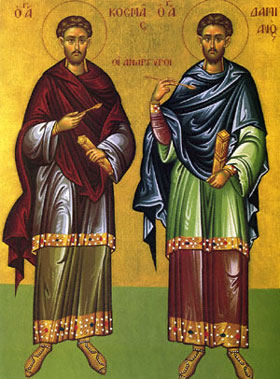
Cosmas and Damian were unmercenaries and miracle-workers. They were brothers
both in the flesh and in the spirit, born somewhere in Asia Minor of a pagan
father and a Christian mother. After their father's death, their mother Theodotia
devoted all her time and effort to educating her sons and raising them as true
Christians. God helped her, and her sons matured as sweet fruit and luminaries
of the world. They were learned in the art of medicine and ministered to the
sick without payment, not so much with medicine as by the name of the Lord Jesus
Christ. They were called ``unmercenary physicians,'' that is, unpaid physicians,
for they healed freely and thus fulfilled the commandment of Christ: Freely ye
have received, freely give (Matthew 10:8). So careful were they in healing men
free of charge that Cosmas became very angry with his brother Damian because
he accepted three eggs from a woman, Palladia, and ordered that he not be buried
alongside his brother Damian after his death. In fact, St. Damian did not accept
these three eggs as a reward for healing the ailing Palladia, but rather because
she adjured him in the name of the Most-holy Trinity to accept these three eggs.
Nevertheless, after their death in the town of Fereman, they were buried together
according to a revelation from God. The holy brothers were great miracle-workers
both during their life and after their death. A snake crawled through the mouth
and into the stomach of a certain farm laborer during his sleep, and the unfortunate
man would have died in the greatest pain had he not, in the last moment, invoked
the help of Saints Cosmas and Damian. Thus, the Lord glorified forever the miracle-working
of those who glorified Him on earth by their faith, purity and mercy.
Martyr Hermeningilda the Goth of Spain (586)
Commemorated on November 1/November 14
Hermenegild was the son of the Gothic King Leovigild who adhered to the Arian
heresy. However, Hermenegild did not turn away from Orthodoxy in spite of all
the flatteries and threats of his cruel heretical father. His father cast him
into prison and, early on Pascha, sent a heretical bishop to administer Communion
to him. But the God-pleaser refused to receive Communion at the hands of a heretic,
and the heretical bishop informed the king about this. The king became angry
and ordered the executioner to behead Hermenegild in the year 586. Leovigild
later repented that he had killed his son; he renounced his heresy and returned
to Orthodoxy.
Martyrs James of Mt. Athos and his two disciples James and Dionysius (1520)
Commemorated on November 1/November 14
James was born in the Diocese of Castoria of parents named Martin and Parasceva.
Working as a shepherd James became wealthy, and by this incurred the envy of
his brother, who maligned him to the Turks as having found some treasure in the
ground. James fled to Constantinople where he again became very wealthy. Once,
James was the guest of a Turkish Bey. The Turks ate meat and James fasted. Then
the Bey said: ``Great is your Christian Faith!'' And he related how his wife
had been mentally ill and how he, after all the physicians and cures had failed,
took her to the patriarch for prayers to be read over her. As soon as the patriarch
opened the book to read, a heavenly light shone forth in the church. After the
completion of the prayer, his wife was made whole. Hearing how the Turk extolled
the Christian Faith, James distributed all his goods and went to the Holy Mountain,
where he was tonsured a monk in the Monastery of Iveron. He lived a life of asceticism
on the Holy Mountain and suffered for the Faith at the hands of the Turks in
Jedrene on November 1, 1520. His miracle-working relics and those of his disciples,
James and Dionysius, repose in the Monastery of St. Anastasia in Galakistou near
Thessalonica.
Martyrs Acindynus, Pegasius, Aphthonius, Elpidephorus, and Anempodistus of Persia
(341)
Commemorated on November 2/November 15
They were all Christians from Persia and suffered during the reign of King Sapor
in the year 355. The first three were servants at the court of this same king
but secretly served Christ their Lord. When they were accused and brought to
trial before the king, he asked them where they came from. To this they replied:
``Our fatherland and our life is the Most-holy Trinity, one in Essence and undivided,
the Father, the Son and the Holy Spirit, One God.'' The king subjected them to
cruel tortures but they endured all heroically, with psalmody and prayer on their
lips. During the time of their torture and imprisonment angels of God appeared
to them many times, and one time the Lord Christ Himself appeared to them as
a man ``with a face radiant as the sun.'' When one of the torturers, Aphthonius,
beheld a miracle, when boiling lead did no harm to the martyrs, he believed in
Christ and cried out: ``Great is the Christian God!'' For this, he was immediately
beheaded, and many others saw and believed. Then the king ordered that Acyndinus,
Pegasius and Anempodistus be sewn into animal skins and cast into the sea. But
St. Aphthonius appeared from the other world with three shining angels, and led
the holy martyrs to dry land and set them free. Elpidephorus was one of the king's
nobles. When he revealed that he was a Christian and denounced the king for his
slaughter of innocent Christians, the king condemned him to death and Elpidephorus
was beheaded along with seven thousand other Christians. Then those first three
martyrs [Acyndinus, Pegasius and Anempodistus] were finally thrown into a burning
furnace along with twenty-eight soldiers and the king's mother, since they also
believed in Christ-and thus, in the flames, they gave up their righteous souls
into the hands of the Lord.
Venerable Marcian of Cyrrhus (388)
Commemorated on November 2/November 15
Marcian was from the town of Cyrus in Syria. He was distinguished by his noble
ancestry as well as by his physical beauty. He left all for the sake of Christ
and withdrew into the wilderness of Halkis to live as a hermit. He was a contemporary
of Patriarch Flavian of Antioch and the Emperors Constantius and Valens. A heavenly
light shone in his cell at night by which he read the Holy Scriptures, and he
never had need of any other light. He was a great miracle-worker both during
his life and after death. Before his death, he ordered his disciple Eusebius
to conceal his body and bury it secretly because of his many admirers. He entered
into rest in the Lord in 387.
The Hieromartyr Victorinus, Bishop of Patav
Commemorated on November 2/November 15
Many maintain that he was a Slovene by ancestry. Blessed Jerome points him out
as a learned and devout man. He knew Greek better than Latin. He wrote the interpretations
of several books of the New and Old Testaments. He suffered for the Christian
Faith in about the year 303.
Martyrs Acepsimas the Bishop, Joseph the Presbyter, and Aeithalas the Deacon,
of Persia (376)
Commemorated on November 3/November 16
Bishop Akepsimos headed the Christian Church in the Persian city of Naesson.
His flock devotedly loved their hierarch for his ascetic life and tireless pastoral
work. The emperor Sapor gave orders to seek out and kill Christian clergy. Saint
Akepsimos also was arrested, being then already an eighty year old man. They
took him to the city of Arbela, where he came before the judge Ardarkh –a
pagan-priest of the sun-god. The holy elder refused to offer sacrifice to the
Persian gods. For this he was fiercely beaten and thrown into prison, where on
the following day they threw in with him, after fierce beatings, the seventy
year old Presbyter Joseph and Deacon Haiphal. For three years the saints were
held in confinement, and worn down by hunger and thirst.
Emperor Sapor came to the temple of the god of fire, located
not far from Arbela, and wanted to take a look at the three holy martyrs. Exhausted
and covered with festering wounds, the saints were brought before the emperor
and at his demand they again firmly refused to worship the pagan gods, instead
confessing their faith in Christ. The holy bishop was beheaded, but the presbyter
and deacon were sent off within the city and there to be stoned.
The execution of the presbyter Joseph was prolonged for several
hours. A guard was placed near the place of execution, so that Christians would
not take the body of the holy martyr. On the fourth night a strong windstorm
raged near the city, –lightning killed the guard, the wind threw about
stones, and the body of Saint Joseph disappeared.
The deacon Haifal was taken to the village of Patrias and
there he was stoned. Christians secretly buried his body. On the grave of the
saint there grew a tree, the fruit of which brought healings.
Dedication of the Church of the Great-martyr George in Lydda (4th c.)
Commemorated on November 3/November 16
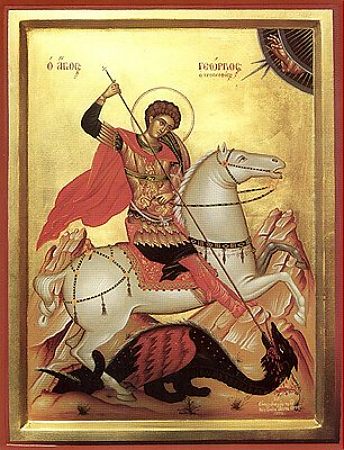
On this day we commemorate the translation of the relics of St. George, from
Nicomedia, where he suffered at the time of Emperor Diocletian, to the city of
Lydda in Palestine. The suffering of this wonderful saint is described on April
23. Anticipating his martyrdom, St. George begged his servant to take his relics
to Palestine, where his mother had been born, and where he had distributed his
large estate to the poor. The servant did so. During the reign of Emperor Constantine,
pious Christians built a beautiful church to St. George in Lydda and, upon the
consecration of that church, the relics of the saint were interred there. Innumerable
miracles have occurred from these miracle-working relics of St. George, the great-martyr
of Christ.
Venerable Elias of Egypt
Commemorated on November 3/November 16
Elias labored in asceticism near Antinoe, the principle city of the Thebaid.
For seventy years, he lived among the arid and inaccessible rocks of the desert.
He ate only bread and dates and, in his youth, fasted for weeks at a time. He
healed all manner of pains and ailments of the people. He eventually became very
shaky in his old age, and entered into the joy of his Lord at the age of 110.
Elias said: ``Guard your mind from evil thoughts concerning your neighbors, knowing
that the demons put them there, aiming to blind you to your own sins and prevent
you from directing yourself toward God.''
Venerable Ioannicius the Great of Bithynia (846)
Commemorated on November 4/November 17

The Monk Ioannikes the Great was born in Bithynia in the
year 752 in the village of Marikat. His parents were destitute and could not
provide him even the basics of an education. From childhood he had to tend the
family cattle –their sole wealth. Love for God and prayer completely held
sway in the soul of the lad Ioannikes. Often, having shielded the herd with the
sign of the Cross, he went to a secluded place and spent the whole day praying,
and neither thieves nor wild beasts came near his herd.
By order of the emperor Leo IV (775-780), a multitude of
officials spread through the cities and towns to draft fine young men for military
service. Young Ioannikes was also drafted into the imperial army. He earned the
respect of his fellow soldiers for his good disposition, but also as a brave
soldier and fierceness to enemies. Saint Ioannikes served in the imperial army
for 6 years. More than once he was rewarded by his commanders and the emperor.
But military service weighed heavily on him, his soul thirsted for spiritual
deeds and solitude. And the Lord summoned His servant to Him for service.
The Monk Ioannikes, having renounced the world, was intent
to go off at once into the wilderness. However, on the advice of an elder experienced
in monastic deeds, he spent a further two years at the monastery. Here the saint
became accustomed to monastic obedience, to monastic rules and practices, he
studied reading and writing, and he learned by heart thirty psalms of David.
After this, on the urging by God, the monk withdrew into the wilderness. For
three years he remained in deep solitude in the wilderness, and only once a month
a shepherd brought him some bread and water. The ascetic spent day and night
in prayer and psalmody. After each verse of singing the psalms the Monk Ioannikes
made a prayer, which in somewhat altered form the Orthodox Church keeps to this
day: "My hope is the Father, my refuge is Christ, and my protection is the
Holy Spirit". By chance encountering his former companions from military
service, the saint quit the wilderness and withdrew to Mount Konturea. Only after
12 years of ascetic life did the hermit accept monastic tonsure. The saint spent
three years after the tonsure in seclusion, wrapped in chains, after which he
set off to Chelidon to the great faster Saint George (Comm. 21 February). The
ascetics spent together three years. During this time the Monk Ioannikes learned
by heart the entire Psalter. Having gotten up in age, the Monk Ioannikes settled
in the Antidiev monastery and dwelt there in seclusion until his end.
The Monk Ioannikes spent 70 years in ascetic deeds and attained
to an high spiritual perfection. Through the mercy of God the saint acquired
the gift of prophecy, as his student Pakhomios has related. The monastic elder
during the time of prayer hovered over the ground. One time he traversed a river
flooded to overflowing. The saint could make himself invisible for people and
make others invisible: one time the Monk Ioannikes led out from prison Greek
captives under the watch of a crowd of guards. Poison and fire, with which the
envious wanted to destroy the saint, did him no harm, and predatory beasts did
not touch him. It is known, that he freed the island of Thasos from a multitude
of snakes. The Monk Ioannikes likewise saved a young nun, who was preparing to
quit the monastery on a whim to marry; he took upon himself the agonised maiden's
suffering of passion, and by fasting and prayer annihilated the seductive assault
of the devil.
Foreseeing his end, Saint Ioannikes expired to the Lord on
4 November 846, at the age of 94.
Hieromartyrs Nicander, bishop of Myra, and Hermas, presbyter (1st c.)
Commemorated on November 4/November 17
Nicander and Hermas were both ordained by Apostle Titus. They were both distinguished
by their great zeal for the Faith and their great labors in winning pagans for
Christ the Lord. Because of this, they were accused before a certain judge, Libanus,
who subjected them to bitter tortures. They were stoned and dragged over stones;
they were imprisoned, suffered hunger and endured many other tortures that no
mortal man could endure without God's special help. The Lord appeared to them
in various ways, and when they were thrown into a fiery furnace, the Lord sent
His angel to cool the flames for them. Finally, they were buried alive by their
cruel torturers. But in vain do men kill those whom the Lord gives life, and
in vain do men dishonor those whom the Lord glorifies.
Martyrs Galacteon and his wife Episteme at Emesa (253)
Commemorated on November 5/November 18
Both Galaction and Episteme were born in the city of Edessa, in Phoenicia. Galaction's
mother was barren until she was baptized. After her baptism, she converted her
husband [Cleitophon] to the true Faith, baptized her son Galaction, and raised
him in the Christian Faith. When Galaction was old enough to marry, his good
mother, Leucippa, entered into rest, and his father betrothed him to a pagan-born
maiden named Episteme. By no means did Galaction want to enter into marriage,
and convinced Episteme to be baptized, then to be tonsured a nun at the same
time that he became a monk. Both of them withdrew to Mount Publion-Galaction
to a monastery and Episteme to a convent. They proved to be shining lights in
their monasteries. They were first in labor, first in prayer, first in humility
and obedience, and first in love. They neither left their monasteries nor did
they see one another until just before their death. A fierce persecution began
and both of them were brought before the tribunal. When the pagans mercilessly
whipped Galaction, Episteme wept. Then they whipped her. After that, they cut
off their hands, their feet and then their heads. Their friend Eutolius took
their bodies and honorably buried them. Eutolius had been a slave of Episteme's
parents, and then a monk with Galaction. He also wrote the life of these wonderful
martyrs of Christ who suffered and received their wreaths in heaven in the year
253.
Apostles Patrobus, Hermas, Linus, Gaius, and Philologus of the Seventy (1st c.)
Commemorated on November 5/November 18
They were of the Seventy. Patrobas was Bishop of Neapolis, Hermes of Philipopolis
(Romans 16:14), Linus of Rome (II Timothy 4:21), Gaius of Ephesus (Roman 16:23),
and Philologus of Synope (Romans 16:15). All of them fulfilled the Law of Christ
with love and took up their abode in the Kingdom of Christ.
Repose of St. Jonah, archbishop of Novgorod (1470)
Commemorated on November 5/November 18

Sainted Jona, Archbishop of Novgorod, in the world named John (Ioann), was early
on left orphaned and then adopted by a certain pious widow living in Novgorod.
She raised the child and sent him off to school. Blessed Michael Klopsky, one
time chancing to meet John on the street, foretold that he would become archbishop
of Novgorod. John received tonsure at the Otensk wilderness-monastery, 50 versts
distant from the city, and he became hegumen of this monastery. It was from here
that the Novgorod people chose him as their archbishop in 1458, after the death
of Sainted Evphymii. Saint Jona enjoyed great influence at Moscow, and during
his time as hierarch the Moscow princes did not infringe upon the independence
of Novgorod. The Moscow Metropolitan Saint Jona (1449-1461) was a friend of the
Novgorod Archbishop Saint Jona, and desired to see him become his successor.
Archbishop Jona built for the first time in the Novgorod lands –a church
in honour of the Monk Sergei of Radonezh (in 1463). Concerning himself over reviving
traditions of the old days in the Novgorod Church, he summoned to Novgorod the
reknown compiler of Saints' Lives –Pakhomii the Logothete, who wrote on
the basis of local sources both services and vitae of the best known Novgorod
Saints.
And to this time period belongs also the beginnings of the
founding of the Solovetsk monastery. Saint Jona rendered much help and assistance
in the organising of the monastery. To the Monk Zosima he gave a special land-grant
letter of blessing (in conjunction with the secular authorities of Novgorod),
by which was bestown over the whole of Solovetsk Island under the land-holdings
of the new monastery.
The saint, after his many toils, and sensing the approach
of his end, wrote a spiritual last-instruction to bury his body at the Otensk
monastery. On 5 November 1470, having communed the Holy Mysteries, the saint
expired to the Lord.
There has survived to the present day a Letter of Saint Jona
to metropolitan Theodosii, written in the year 1464. The life of the saint was
written in the form of a short account in the year 1472 (included in the work, "Memorials
of Old Russian Literature", and likewise in the "Veliki Chet'i-Minei" ("Great
Reading Menaion") of Metropolitan Makarii, under 5 November). In 1553, after
the uncovering of the relics of Archbishop Jona, an account was compiled about
this event, from the pen of the monk Zinovii of Otensk. A special work about
the miracles of the saint is to be met with in manuscripts of the XVII Century.
St. Paul the Confessor, archbishop of Constantinople (350)
Commemorated on November 6/November 19
Sainted Paul, Archbishop of Constantinople, was chosen to the patriarchal
cathedra-seat after the death of Patriarch Alexander (+ 340), when the Arian
heresy had again flared up. Many of the Arians were present at the Council which
selected the new Constantinople patriarch. They revolted in opposition to the
choice of Saint Paul, but the Orthodox at the Council were in the majority. The
emperor Constantius, ruling over the Eastern half of the Roman empire, was an
Arian. At the time of the election of the patriarch he was not in Constantinople.
Upon his return, he convened a council, which illegally declared the dethronement
of Saint Paul, and the emperor banished him from the capital. In place of the
saint they raised up Eusebios of Nicomedia. Patriarch Paul withdrew to Rome,
where also were other Orthodox bishops banished by Eusebios.
Not for long did Eusebios rule the Constantinople Church.
When he died, Saint Paul returned to Constantinople. He was greeted by his flock
with love. But Constantius exiled the saint a second time, and so he returned
to Rome. The Western emperor Constans wrote his Eastern co-ruler an harsh letter,
which he dispatched to Constantinople along with the holy exiled archpastor.
The threats worked, and Saint Paul was reinstated upon the patriarchal throne.
But soon the pious emperor Constans, a defender of the Orthodox,
was treacherously murdered during a palace coup. They again banished Saint Paul
from Constantinople and this time sent him off in exile to Armenia, to the city
of Kukuz, where he accepted a martyr's death. When the Patriarch was celebrating
the Divine Liturgy, Arians rushed upon him by force and strangled him with his
own hierarchical omophor. This occurred in the year 350. In the year 381 the
holy Emperor Theodosius the Great solemnly transferred the relics of Saint Paul
the Confessor from Kukuz to Constantinople. In 1326 the relics of Saint Paul
were then transferred to Venice.
Saint Athanasias the Great, a contemporary of Saint Paul,
writes briefly about his exiles: "Saint Paul the first time was dispatched
by Constantine to Pontus, the second time fettered in chains by Constantius,
and then he was locked up in Mesopotamian Syngara and from there moved to Emesus,
and the fourth time to Cappadocian Kukuz in the Taurian wilderness".
Venerable Barlaam, abbot of Khoutyn (Novgorod) (1192)
Commemorated on November 6/November 19
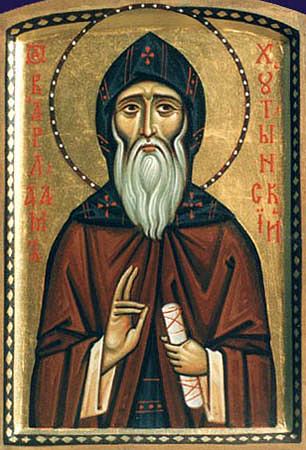
Barlaam was born and raised as a Christian in Novgorod the Great. After the death
of his parents, he was tonsured a monk and devoted himself to a life of strict
asceticism. He founded a monastery on the bank of the Volkhov River, at a place
where a heavenly light appeared to him. Barlaam was a great miracle-worker both
during his life and after his death: he saw into the secrets of men's hearts,
expelled unclean spirits and healed all sicknesses. After his repose, a servant
of Prince Vasili Vasilievich became gravely ill and begged to be taken to the
saint's grave. He further instructed them that, if he should die on the way,
they should carry his dead body to the saint. And thus it happened-he died on
the way and they carried him dead to the monastery, where he returned to life,
stood up and prostrated before the grave of the saint. In the year 1471, Tsar
Ivan the Terrible ordered that the saint's grave be dug up. As soon as they began
to dig, a flame sprang from the grave and flared up along the walls of the church.
The Tsar was so frightened that he ran out of the church and, in his haste, forgot
his staff, which is still preserved beside the grave of the saint. The commemoration
of this miracle is celebrated on the Friday after the Sunday of All Saints.
Holy 33 Martyrs of Melitene: Hieron, Hesychius, Nicander, Athanasius, Manias,
Barachius, Callinicus, Theogenes, Nicon, Longinus, Theodore, Valerius, Xanthius,
Theodulus, Callimachus, Eugene, Theodochus, Ostrychius, Epiphanius, Maximian,
Ducitius, Claudian, Theophilus, Gigantius, Dorotheus, Theodotus, Castrychius,
Anicletus, Theomelius, Eutychius, Hilarion, Diodotus, and Amonitus (290)
Commemorated on November 7/November 20
Hieron was born in Tyana in Cappadocia of a good and devout mother, Stratonika,
who was blind. Hieron was a very zealous Christian and served his blind mother
with great filial love. For two reasons he did not wish to join the army, and
he resisted and drove off those who had been sent to take him. Hieron was loath
to leave his helpless mother, and it was grievous for him even to consider that,
as a soldier, he would be compelled to offer sacrifices to idols. Finally, Hieron
was arrested along with other Christians, and they were all taken before the
eparch of the town of Melitene. While they were still on the road, a man clad
in a brilliant white garment appeared to Hieron one night and said: ``Behold,
Hieron, I proclaim salvation to you: you shall not wage war for an earthly king,
but for the Heavenly King you will complete your struggle, and you shall soon
come to Him to receive honor and glory.'' At this, Hieron's heart was filled
with inexpressible joy. In Melitene they were all thrown into prison and Hieron,
with great zeal, strengthened all the prisoners in the Faith, urging that not
even one of them fall away, but that all willingly offer their bodies to torture
and death for Christ. All but one confessed their faith in the Lord Jesus Christ.
The exception was Hieron's kinsman Victor, who fell away from the Faith. The
tormentors cut one of Hieron's hands off, then flogged and tortured him in various
ways until they beheaded him and the others. Going to the place of execution,
these thirty-three martyrs chanted the Psalm: Blessed are the undefiled in the
way, who walk in the law of the Lord (Psalms 118:1). Here we will name the honorable
martyrs whose names are written with his in the Book of Life: Hesychius, Nicander,
Athanasius, Mamas, Barachius, Callinicus, Theogenes, Nikon, Longinus, Theodore,
Valerius, Xanthius, Theodulus, Callimachus, Eugenius, Theodochus, Ostrichius,
Epiphanius, Maximian, Ducitius, Claudian, Theophilus, Gigantius, Dorotheus, Theodotus,
Castrichius, Anicletus, Themilius, Eutychius, Hilarion, Diodotus and Amonitus.
A man named Chrysanthus purchased Hieron's severed head and honorably buried
it, later building a church over it in the saint's name. The martyr's severed
hand was brought to his blind mother. St. Hieron, with his companions, suffered
in the year 298 and entered the glory of Christ.
Martyrs Auctus, Taurion, and Thessalonica at Amphipolis in Macedonia
Commemorated on November 7/November 20
Saint Thessalonikia was the daughter of a pagan priest. When the impious father
learned that his daughter was become a Christian, he ruthlessly beat her and
threw her out of the house, bereft of any means of providing for herself. Saints
Auktos and Taurion attempted to intercede for the girl and to reason with the
embittered father. The pagan priest denounced them both to the authorities, and
they were arrested. Having confessed their faith in Christ afront the torturers
and having undergone cruel tortures, the saints were then beheaded. Soon after
their martyr's death, Saint Thessalonikia also died. Her body was reverently
buried in the city of Amphypolis in Macedonia, together with the holy Martyrs
Auktos and Taurion.
Venerable Lazarus the Wonderworker of Mt. Galesion near Ephesus (1054)
Commemorated on November 7/November 20
A pillar of light appeared above the house where he was born. Lazarus left his
village of Magnesia and went to Jerusalem on a pilgrimage to the holy places.
There, he was tonsured a monk in the Monastery of St. Sava the Sanctified. After
ten years, he settled on Mount Galesius and lived a life of asceticism on a pillar
as a stylite. Lazarus was a miracle-worker both during his life and after death.
Emperor Constantine Monomachus had great respect for him. Attaining old age,
St. Lazarus entered into eternity toward the end of the eleventh century.
Synaxis of the Archangel Michael and the other Bodiless Powers: the Archangels
Gabriel, Raphael, Uriel, Salaphiel, Jegudiel, Barachiel, and Jeremiel
Commemorated on November 8/November 21
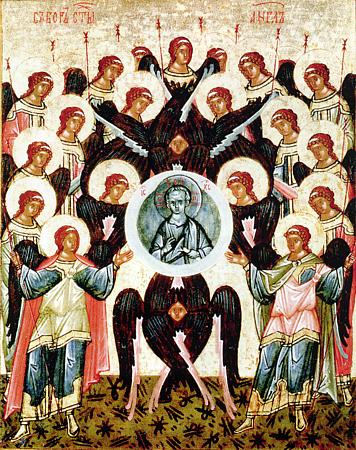
The angels of God were celebrated by men from earliest times but this celebration
was often turned into the divinization of angels (II Kings 23:5). The heretics
wove all sorts of fables concerning the angels. Some of them looked upon angels
as gods; others, although they did not consider them gods, called them the creators
of the whole visible world. The local Council of Laodicea (four or five years
before the First Ecumenical Council) rejected the worship of angels as gods and
established the proper veneration of angels in its Thirty-fifth Canon. In the
fourth century, during the time of Sylvester, Pope of Rome, and Alexander, Patriarch
of Alexandria, the present Feast of Archangel Michael and all the other heavenly
powers was instituted for celebration in the month of November. Why precisely
in November? Because November is the ninth month after March, and March is considered
to be the month in which the world was created. Also, as the ninth month after
March, November was chosen for the nine orders of angels who were created first.
St. Dionysius the Areopagite, a disciple of the Apostle Paul (who was taken up
into the third heaven), described these nine orders of angels in his book, On
the Celestial Hierarchies, as follows: six-winged Seraphim, many-eyed Cherubim,
God-bearing Thrones, Dominions, Powers, Virtues, Principalities, Archangels,
and Angels. The leader of all the angelic hosts is the Archangel Michael. When
Satan, Lucifer, fell away from God and drew a part of the angels with him to
destruction, then Michael stood up and cried out before the faithful angels:
``Let us attend! Let us stand aright! Let us stand with fear!'' and all of the
faithful angelic heavenly hosts cried out: ``Holy! Holy! Holy! Lord God of Sabaoth!
Heaven and earth are full of Thy glory!'' Concerning the Archangel Michael, see
Joshua 5:13-15 and Jude 1:9. Among the angels there reign perfect oneness of
mind, oneness of soul, and love. The lower orders also show complete obedience
to the higher orders, and all of them together to the holy will of God. Every
nation has its guardian angel, as does every Christian. We must always remember
that whatever we do, in open or in secret, we do in the presence of our guardian
angel. On the day of the Dread Judgment, the multitude of the hosts of the holy
angels of heaven will gather around the throne of Christ, and the deeds, words,
and thoughts of every man will be revealed before all. May God have mercy on
us and save us by the prayers of the Archangel Michael and all the bodiless heavenly
powers. Amen.
Martyrs Onesiphorus and Porphyrius of Ephesus (284)
Commemorated on November 9/November 22
The Holy Martyrs Onesyphoros and Porphyrios suffered during the time of persecution
against Christians by the emperor Diocletian (284-305). They beat them and burned
them with fire. After this, they tied the saints to wild horses, which dragged
them over the stones, after which the Martyrs Onesyphoros and Porphyrios died.
Believers gathered the lacerated remains of the saints and reverently buried
them.
Venerable John the Short of Egypt (422)
Commemorated on November 9/November 22
The Monk John the Short-Statured (Kolobos) asceticised in the Egyptian
wilderness in the V Century in the monastery of the Monk Pimen the Great (Comm.
27 August). From the name of this monastery, monastic wilderness monasteries
began to be called "sketes", in which monks pursued asceticism in strict
solitude and silence. The Monk John was a gentle, humble and work-loving monk.
It was to this monastery that the young John came with his brother Daniel. At
first John asceticised without spiritual guidance, but the Lord brought him to
his senses, in that strict ascetic deeds need to be done under the observation
of an elder (starets) experienced in the spiritual life. One time the Monk John
told his brother that he did not want to be concerned about clothing and food,
and that he wished to live like the Angels. Having removed his clothing, he went
out from the cell. At night it was very cold, and the scantily-clad John soon
began to tap on the door of the cell. Daniel did not immediately remind his brother
the saying that an Angel is not concerned about its body. The Monk John realised,
that he relied too much on himself and bitterly he wept. After being brought
to his senses the Monk John went to the Monk Pimen, known for his firm and steadfast
will, and having asked guidance, he promised to be obedient in all things. Testing
the patience of the young monk, Saint Pimen gave him an unusual obedience. For
three years the Monk John carried water and poured it on a dried-up tree, and
it became covered with leaves and gave abundant fruit, and was given the name "the
tree of obedience". The Monk John afterwards himself became a guide of many
people on the way of salvation, among which were the Monk Arsenios the Great
(Comm. 8 May) and Blessed Taisia (Comm. 10 May).
Saint John was the author of the Life of the Monk Paisias
the Great (Comm. 19 June).
Venerable Matrona, abbess, of Constantinople (492)
Commemorated on November 9/November 22
Matrona was from Perga in Pamphylia. Matrona's marriage to Dometian, a nobleman
of Constantinople, soon became unbearable to her. Disguised in men's clothing,
she fled and adopted the name Babylas, then entered the Monastery of St. Bassian
in Constantinople. Because her husband searched for her constantly, she was forced
to move repeatedly. Altogether, she moved to Emesa, Sinai, Jerusalem and Beirut,
and finally returned to Constantinople. Matrona was tonsured a nun at age twenty-five,
and lived the ascetic life for seventy-five years. In all she lived a hundred
years, and died peacefully in the year 492 as abbess of a monastery in Constantinople,
taking up her abode in the joy of her Lord.
Venerables Euthymius (990) and Neophytus, the Serbians of Mt. Athos
Commemorated on November 9/November 22
Euthymius and Neophytus were Serbs by birth and kinsmen of high-ranking aristocrats
in Byzantium. Euthymius was a companion of St. Athanasius and the steward of
his Lavra, after which he founded the Monastery of Dochiariou. He entered peacefully
into rest in the year 990. His nephew Neophytus succeeded him as abbot of Dochiariou,
increased the brotherhood and built a large church. He entered into rest at the
beginning of the eleventh century.
Venerable Simeon Metaphrastes of Constantinople (960)
Commemorated on November 9/November 22
Simeon was a gifted Constantinopolitan. He had both a secular and spiritual education.
He attained the rank of imperial logothete [chancellor] and was first among the
nobles at the imperial court, yet he lived a pure and blameless life as a true
ascetic. He distinguished himself by great military bravery and statesmanly wisdom.
For these qualities, Emperor Leo the Wise greatly respected him and sent him
to Crete to negotiate a peace with the Arabs who then occupied the island. Successfully
completing his mission, he returned to Constantinople and soon thereafter withdrew
from the world and worldly affairs. He wrote many lives of saints, compiling
122 new biographies and correcting 539 biographies. He entered into rest in about
the year 960, and a fragrant and healing myrrh flowed from his relics.
Venerable Theoctiste of the isle of Lesbos (881)
Commemorated on November 9/November 22
Theoctista was born on the island of Lesbos and was tonsured a nun at the age
of seventeen. The savage Saracens attacked the island and enslaved all who fell
into their hands, including Theoctista and her sister. When the Saracens brought
the slaves to the marketplace on the island of Paros, Theoctista escaped from
the crowd and hid in an abandoned church in the middle of the island, where she
lived a life of asceticism for thirty-five years. She entered into rest in the
year 881.
Apostles Erastus, Olympas, Herodion, Sosipater, Quartus, and Tertius of the Seventy
(1st c.)
Commemorated on November 10/November 23
The Holy Disciples from the 70: Herastos, Olympos, Rodion, Sosipater, Kuartos
(Quartus) and Tercias lived during the I Century.
Saint Rodion, or Herodian, was a kinsman of the Apostle Paul
(Rom. 16: 11), and left the bishop's cathedra (chair) at Patras so as to go to
Rome with the Apostle Peter. The holy Disciple Olympos (or Olympian), –about
whom the holy Apostle Paul recollects (Rom. 16: 15), was also a companion of
the Apostle Peter. Both of these Disciples from the 70 were beheaded on the very
day and hour, when the Apostle Peter was crucified.
The holy Disciples Herastos, Sosipater, Quartus and Tercias
were disciples of the holy Apostle Paul. The Apostle to the Gentiles speaks of
them in the Epistle to the Romans: "Jason and Sosipater, my kinsmen, do
greet you..." (Rom. 16: 21); "And also do I, Tercias, who wrote down
this epistle, greet you" (Rom. 16: 22); "And Herastos, the city treasurer,
doth greet you, and brother Quartus" (Rom. 16: 23).
The Disciple Sosipater, a native of Achaeia, was bishop of
Iconium where also he died. The Disciple Herastos was at first a deacon and treasurer
of the Jerusalem Church, and later on bishop at Paneadis. The holy Disciple Quartus
endured much suffering for his piety and converted many pagans to Christ, dying
peacefully in the dignity of bishop in the city of Beirut. The holy Disciple
Tercias, having written down the dictation of the Apostle Paul contained in the
Epistle to the Romans, was the second bishop of Iconium, where also he died.
Martyr Orestes of Cappadocia (304)
Commemorated on November 10/November 23
Orestes was from the town of Tyana in Cappadocia. He was a Christian from birth
and a physician by profession. He was harshly tortured by a certain wicked eparch
Maximus during the reign of Diocletian. When the eparch at first advised him
to deny Christ and worship idols, Orestes replied: ``If you knew the power of
the Crucified One, you would reject idolatrous falsehoods and worship the true
God.'' For this, he was savagely beaten, scraped, pulled apart on the rack, burned
with a red-hot iron, and cast into prison to die of starvation. The young Orestes
spent seven days without bread or water. On the eighth day, he was again brought
before the eparch who threatened him with frightening tortures. Orestes answered:
``I am prepared to endure every pain, having the sign of my Lord Jesus Christ
inscribed on my heart.'' The governor condemned him, and the torturers hammered
twenty iron nails into his feet and tied him to a horse, dragging him over thorns
and rocks until the martyr of God breathed his last. On the place where they
discarded Orestes's body, a man bright as the sun appeared, gathered Orestes's
relics, and carried them to a hill near the town of Tyana, honorably burying
them there. This wonderful saint appeared to St. Dimitri of Rostov after his
repose, and showed him all the wounds on his body.
St. Nonnus, bishop of Heliopolis (471)
Commemorated on November 10/November 23
Nonnus was renowned as a great ascetic in the Tabennisiot monastery in Egypt.
Because of this, he was chosen Bishop of the diocese of Edessa in 448. Later,
he was translated to the diocese of Heliopolis, and there converted 30,000 Arabs
to the Christian Faith. After the death of Bishop Ibo, St. Nonnus returned to
Edessa, where he remained until his repose in 471. Through his prayers, the infamous
sinner Pelagia (who was later glorified for her holiness of life), was converted
to the Christian Faith.
Martyr Menas of Egypt (304)
Commemorated on November 11/November 24
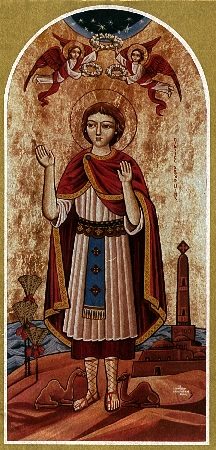
The Holy GreatMartyr Menas, an Egyptian by birth, was a soldier
and served in the city Kotuan under the centurion Firmilian during the reign
of the emperors Diocletian and Maximian (284-305). When the co-emperors began
the then fiercest persecution against Christians in history, the saint lost all
desire to serve these persecutors and, having left the service, he withdrew to
a mountain, where he asceticised in fasting and prayer. Once during the time
of a pagan feastday he happened to arrive in the city, in which earlier he had
served. At the climax of the festal games, which all the city had come out to
see, rang out the accusing voice of the saint of God, preaching faith in Christ,
the Saviour of the world.
At trial before the governor Pyrrhos the saint bravely confessed
his faith and said, that he had come hither, in order to denounce all of impiety.
Saint Menas spurned he suggestion to offer sacrifice to the pagan gods, and he
was put to cruel tortures, after which he as beheaded. This occurred in the year
304. The body of the holy martyr as ordered to be burnt. Christians by night
gathered up from the burnt-out fire the undestroyed remains of the martyr, which
later were installed in a church in his name, built after the cessation of the
persecution at the place of the suffering and death of the GreatMartyr Menas.
Great-martyr Stephen-Urosh III of Dechani, Serbia (1331)
Commemorated on November 11/November 24
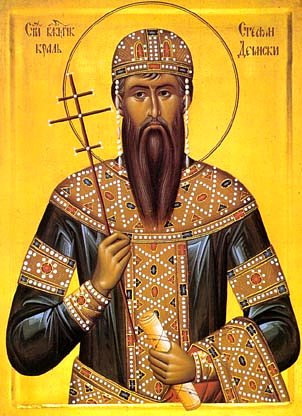
He became famous by his piety, love for building temples to God (he constructed
the Dechani monastery) and compassion for the poor. Having led most of his life
under the oppression of various disasters, Saint Stephen died a martyr. He was
strangled by agents of his own son in Zvelane 1336. His relics are in the Dechani
Monastery.
Martyrs Victor at Damascus (160) and Stephanida (Stephanis) of Spain (161)
Commemorated on November 11/November 24
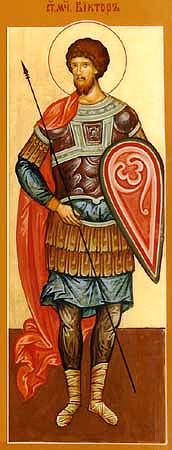
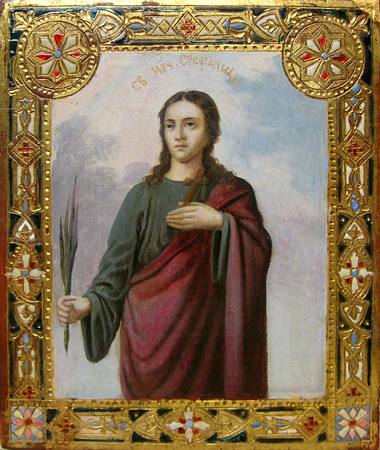
The Holy Martyr Victor was a soldier during the reign of the emperor Marcus Auelius
the Philosopher (161-180). When the emperor began a persecution against Christians,
Victor refused to offer sacrifice to the pagan gods. Such obligatory sacrifices
were made as a test of the loyalty of a soldier to the gods, the emperor and
the state. The saint was given over to torture, but he came through all the torments
unharmed. By the power of prayer he was victorious over a sorcerer, who from
that point in time gave up give sorcery and became a Christian. Through the prayer
of the saint, blind soldiers were suddenly restored their sight. Beholding the
miracle, manifest by the Lord through Saint Victor, a young pious spouse of one
of the torturers, Stephanida, openly glorified Christ, for which she was condemned
to cruel execution: they tied her to two bended-over palm trees, which in springing
back straight tore apart the martyress. The holy Martyr Victor was beheaded.
The martyrs suffered in the II Century at Damascus, where also heir venerable
remains were consigned to burial.
Martyr Vincent of Spain (304)
Commemorated on November 11/November 24
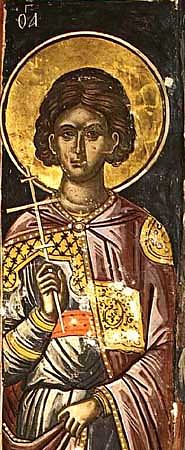
Born in Spain, he was a deacon in the city of Augustopolis. During the persecution
of Christian under Diocletian he was given over for crucifixion in the city of
Valencia. Miraculously saved from death on the cross, St. Vincent then was burnt
on an iron grid. His relics today repose in Rome.
Venerable Theodore the Confessor, abbot of the Studion (826)
Commemorated on November 11/November 24
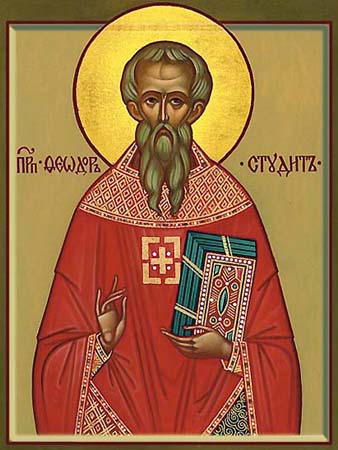
The Monk Theodore the Studite was born in the year 758 at Constantinople into
a family of the imperial tax-collector Photinos and his spouse Theoktista –both
pious Christians. The Monk Theodore received a serious and systematic education
from the best rhetoricians, philosophers and theologians within the capital city.
During this time in the Byzantine empire the Iconoclast heresy
had become widespread, and it was supported also by the impious emperor Constantine
Kopronymos (741-775). the views of the emperor-iconoclast and his court decidedly
conflicted with the religious sensitivity of Photinos, who was fervently an adherent
of Orthodoxy, and so he left government service. Later on the parents of Saint
Theodore, by mutual consent, gave away their substance to the poor, took their
leave of each other and accepted monastic tonsure. Their son Theodore soon became
widely known in the capital for his participation of the then numerous disputes
concerning icon-veneration. Accomplished in the oratorical art, and with a free
command of terminology and logic of the philosophers, and chief thing of all,
a profound knowledge of Christian dogmatics, adept in the letter and the spirit
of the Holy Scriptures, –all this invariably brought victory in the disputes
to Saint Theodore, the zealous denouncer of the Iconoclast heresy.
The VII OEcumenical Council put an end to the Church dissensions.
It was convened through the initiative and under the auspices of the pious Empress
Irene. The OEcumenical Council through its settings as he highest authority in
the life of the Church forever denounced and spurned Iconoclasm.
Among the fathers of the Council was Blessed Platon (Comm.
5 April), an uncle of Saint Theodore, and who for a long time had asceticised
on Mount Olympos. An elder and lofty of life, Blessed Platon at the conclusion
of the Council summoned his nephews –Theodore together with his brothers
Joseph and Euthymios –to the monk's life in the wilderness. The brothers
gratefully accepted the guidance of their kinsman, experienced in the spiritual
life.
Having departed Constantinople, they set off to the locale
of Sakudian, not far from Olympos. The solitude and the beauty of the place,
its difficulty of access for unaspiring people, met with the approval of the
elder and his nephews, and they decided to remain here. The brothers built a
church in the name of Saint John the Theologian, and gradually there began to
throng here those thirsting for monastic deeds. And thus arose a monastery, the
hegumen of which was Blessed Platon.
The life of the Monk Theodore was truly ascetic. He toiled
at his own heavy and dirty work. He strictly kept fast, and each day he made
confession to his spiritual father –the starets-elder Platon, revealing
to him all his doings and thoughts, and carefully he fulfilled all his counsels
and guidances. Theodore daily made time for spiritual reflection, he bared his
soul to God, unburdened of any earthly concern, making as it were a certain secret
service to Him. The Monk Theodore unfailingly read the Holy Scripture and works
of the holy fathers, among them finding his closest affinity to the works of
Saint Basil the Great.
After several years of the monk's life, the Monk Theodore
accepted the dignity of presbyter at the guidance of his spiritual father. When
Blessed Platon went to his repose, the brethren unanimously chose the Monk Theodore
as hegumen of the monastery. Swayed at the wish of his confessor, the Monk Theodore
accepted being chosen, but imposed upon himself still greater deeds of asceticism.
He taught the brethren by the example of his own virtuous life and also by fervent
fatherly instruction.
When the emperor transgressed against the Church's canons,
the events of outside life disturbed the tranquillity in the monastic cells.
The Monk Theodore bravely distributed a circular missive through the monasteries,
in which he declared the emperor Constantine VI (780-797) excommunicated from
the Church for abusing the Divine regulations concerning Christian marriage.
The Monk Theodore and ten of his co-ascetics were sent into exile to the city
of Soluneia (Thessalonika). But there also the accusing voice of the monk continued
to ring out. Upon her return to the throne, Saint Irene in 796 set free the Monk
Theodore, and gave over to him the desolate Studite monastery near Kopronyma.
The saint soon gathered to the monastery about 1,000 monks. For governing the
monastery the Monk Theodore wrote an ustav-rule of monastic life, since called
the "Studite rule". The Monk Theodore likewise came out with many missives
against the Iconoclasts. For his dogmatic works, and also the canons and triodes
written by him, Blessed Theoktistos termed the Monk Theodore "a fiery teacher
of the Church".
When Nicephoros seized the imperial throne, deposing the
pious Empress Irene, he likewise crudely transgressed against Church regulations
by restoring to the Church on his own authority an earlier excommunicated presbyter.
The Monk Theodore again came out with denunciation of the emperor. After torture
the monk was again sent into exile, where he spent more than two years. The monk
was then set free by the gentle and pious emperor Michael, who succeeded to the
throne upon the death of Nicephoros and his son Staurikios in a war against barbarians.
Their death for a long while had been foretold by the Monk Theodore.
In order to avert civil war, the emperor Michael abdicated
the throne to his military commander Leo the Armenian. The new emperor proved
to be an iconoclast. The hierarchs and teachers of the Church attempted to reason
with the impious emperor, but in vain. Leo prohibited the veneration of holy
icons and gave them over for abuse. In answer to such iniquity, the Monk Theodore
with the brethren made a religious procession around the monastery with highly
raised icons and the singing of the tropar to the image of the Saviour Not-Made-by-Hand
(Comm. 16 August). The emperor angrily threatened the saint with death, but the
monk openly continued to encourage believers in Orthodoxy. Then the emperor sentenced
the Monk Theodore and his student Nicholas to exile, at first in Illyria at the
fortress of Metopa, and later in Anatolia at Boneta. But even from prison the
confessor continued his struggle against heresy.
Tormented by the executioners which the emperor sent to Boneta,
deprived almost of food and drink, covered over with sores and barely alive,
Theodore and Nicholas endured everything with prayer and thanksgiving to God.
At Smyrna, where they dispatched the martyrs from Boneta, the Monk Theodore healed
from a terrible illness a military commander –a nephew of the emperor and
like-minded with him, by having ordered him to repent of the wicked doings of
Iconoclasm. But the fellow again later relapsed into heresy, and then died.
Having been murdered by his own soldiers, Leo the Armenian
was replaced by the equally impious though tolerant emperor Michael II Traulos
(the Stammerer). The new emperor set free all the Orthodox fathers and confessors
from prison, but in the capital he prohibited icon-veneration. The Monk Theodore
did not want to return to Constantinople and so decided to settle in Bithynia
in the city of Chersonessus, near the church of the holy Martyr Tryphon. In spite
of serious illness, the Monk Theodore celebrated Divine Liturgy daily and instructed
the brethren. Foreseeing his end, the saint summoned the brethren and in last
wishes bid them to preserve Orthodoxy, to venerate holy icons and observe the
monastic ustav-rule. Then he ordered the brethren to take candles and sing the
canon for the parting of the soul from the body. Just before the singing of the
words "I forget not Thine commandments ever, for in them hath I lived" –the
Monk Theodore expired to the Lord, in the year 826.
At this selfsame hour there occurred a vision to the Monk
Ilarion of Dalmatia (Comm. 6 June). An heavenly light shone amidst singing and
the voice was heard: "This is the soul of the Monk Theodore, having suffered
even to the extent of its blood for holy icons, which now departeth unto the
Lord".
The Monk Theodore during his life and after his death worked
many a miracle: those invoking his name have been delivered from conflagrations,
from attack of wild beasts, they have received healing, thanks to God and to
His holy saint –the Monk Theodore the Studite.
On 26 January is celebrated the memory of the transfer of
the relics of the Monk Theodore the Studite from Chersonessus to Constantinople
in the year 845.
St. John the Merciful, patriarch of Alexandria (620)
Commemorated on November 12/November 25

John was born on the island of Cyprus. His father was Prince Epiphanius. John
was raised as a true Christian from childhood. At the insistence of his parents,
he married and had children. However, by God's providence, his wife and children
passed from this world into the next. Renowned for his compassion and piety,
John was chosen as Patriarch of Alexandria in the time of Emperor Heraclius.
He governed the Church of Alexandria for ten years as a true shepherd, safeguarding
it from pagans and heretics. He was a model of meekness, charity and love for
his fellow men. He said: ``If you desire nobility, seek it not in blood but in
virtues, for this is true nobility.'' All the saints have been distinguished
by mercifulness, but St. John was completely dedicated to this wonderful virtue.
Once, while celebrating the Liturgy, the patriarch remembered the words of Christ,
Therefore if thou bring thy gift to the altar, and there rememberest that thy
brother hath aught against thee, leave there thy gift before the altar, and go
thy way; first be reconciled to thy brother, and then come and offer thy gift
(Matthew 5:23-24), and he remembered that one of the clergy in that church had
a grievance against him. He quickly left the Holy Gifts, approached that priest,
fell before his feet and begged for forgiveness. And only when he had made peace
with this man did he return to the table of oblation. Another time, as he was
on his way to the Church of Saints Cyrus and John, it happened that he met a
needy and unfortunate widow who spoke to him at length about her misfortune.
The patriarch's escorts became bored by the woman's lengthy complaint, and urged
the bishop to hurry to the church for the service, intimating that he could hear
the woman's story afterward. John said to them: ``And how will God listen to
me, if I do not listen to her?'' He would not leave until he heard the widow's
complaint to the end.
When the Persians attacked Egypt, Patriarch John boarded a boat to escape from
danger. Along the way he fell ill and, when he arrived in Cyprus, he reposed
at his birthplace, in the year 620. After he entered the Immortal Kingdom of
his Lord, his miracle-working relics were translated to Constantinople, then
to Budapest, and finally to Presburg.
Prophet Ahijah (Achias) (960 B.C.)
Commemorated on November 12/November 25
The Holy Prophet Akhiah (Ahijah), (cf. 1 [3] Kings 11: 29ff) –was a contemporary
of Solomon, and was born in the city of Silom. The prophet predicted to Jeroboam
his kingly rule over the 10 Tribes of Israel, which God would grant him, snatching
them away from the hands of Solomon. Afterwards Akhiah predicted to Jeroboam
the perishing of all his line. All the predictions of the prophet were fulfilled.
The Prophet Ahiah died in old age 960 years before the Birth of Christ.
Venerable Nilus the Faster of Sinai (451)
Commemorated on November 12/November 25
Nilus was at first a prefect in the capital city, Constantinople. As a married
man, he had a son and a daughter. Seeing the sinful life of the capital, he agreed
with his wife to withdraw from the world. This they did. His wife and daughter
went to a convent in Egypt. Nilus and his son Theodulus went to Mount Sinai.
Nilus lived a life of asceticism on Mount Sinai for a full sixty years. He wrote
wonderful books on the spiritual life. He entered peacefully into rest in about
the year 450, in the eightieth year of his earthly existence, and took up his
habitation in the blessed heavenly life. These holy words are his: ``Physical
passions have their origin in physical desires, and against them abstinence is
necessary; but spiritual passions are born of spiritual desires, and against
them, prayer is necessary.''
St. Nilus the Myrrh-gusher of Mt. Athos (1651)
Commemorated on November 12/November 25
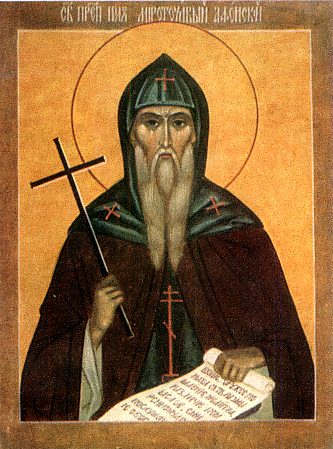
The Monk Nilos the Myrh-Exuding was born in Greece, in a village named for Saint
Peter, in the Zakoneia diocese. He was raised by his uncle, the priestmonk Makarios.
Having attained the age of maturity, he took monastic tonsure and was found worthy
of ordination to monk-deacon, and then to priestmonk. The desire for great effort
at monastic deeds brought the monastic uncle and nephew to Athos, where Makarios
and Nilos asceticised, at a place called the Holy Rocks. Upon the repose of Blessed
Makarios, the Monk Nilos in undertaking still more intense spiritual efforts
resettled in a place well nigh inaccessible for any living thing. Upon his departure
to the Lord, the Monk Nilos was glorified by an abundant flow of curative myrh,
for which Christians journeyed from the most distant lands of the East.
St. John Chrysostom, archbishop of Constantinople (407)
Commemorated on November 13/November 26
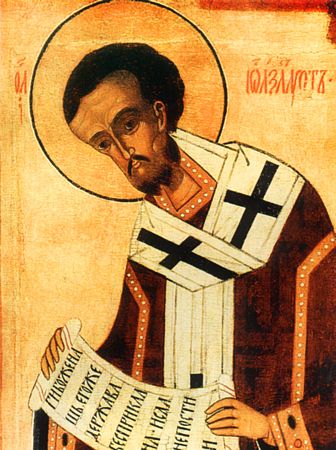
John was born in Antioch in the year 354. His father, Secundus, was an imperial
commander and his mother's name was Anthusa. Studying Greek philosophy, John
became disgusted with Hellenic paganism and adopted the Christian Faith as the
one and all-embracing truth. Meletius, Patriarch of Antioch, baptized John, and
his parents also subsequently received baptism. Following his parents' repose,
John was tonsured a monk and lived a strict life of asceticism. He then wrote
a book, On the Priesthood, after which the Holy Apostles John and Peter appeared
to him, and prophesied that he would have a life of great service, great grace
and great suffering. When he was to be ordained a priest, an angel of God appeared
simultaneously to John and to Patriarch Flavian (Meletius's successor). While
the patriarch was ordaining John, a shining white dove was seen hovering over
John's head. Glorified for his wisdom, asceticism and power of words, John was
chosen as Patriarch of Constantinople at the behest of Emperor Arcadius. As patriarch,
he governed the Church for six years with unequalled zeal and wisdom. He sent
missionaries to the pagan Celts and Scythians and eradicated simony in the Church,
deposing many bishops guilty of this vice. He extended the charitable works of
the Church and wrote a special order of the Divine Liturgy. He shamed the heretics,
denounced Empress Eudoxia, interpreted Holy Scripture with his golden mind and
tongue, and bequeathed the Church many precious books of his homilies. The people
glorified him, the envious loathed him, and the Empress, on two occasions, sent
him into exile. John spent three years in exile, and reposed as an exile on the
Feast of the Elevation of the Precious and Life-giving Cross, September 14, 407,
in the town of Comana in Georgia. Before his repose, the Holy Apostles John and
Peter appeared to him again, as did the Holy Martyr Basiliscus (May 22) in whose
church he received Communion for the last time. His last words were, ``Glory
be to God for all things,'' and with that, the soul of the golden-mouthed patriarch
was taken into Paradise. Chrysostom's head reposes in the Church of the Dormition
in Moscow, and his body reposes in the Vatican in Rome.
Martyrs Antoninus, Nicephorus, and Germanus of Caesarea in Palestine (308)
Commemorated on November 13/November 26
The first three were watching the pagans worshiping idols with shouts and dancing
at one of their feasts. Fearlessly, they went before the crowd and preached the
One God in Trinity. Firmilian-the eparch of Palestinian Caesarea, where this
occurred-was so enraged at the action of these three Christians that he commanded
their immediate beheading. Manetha was a Christian maiden who followed the martyrs
as they were being led to the place of execution. She too was arrested, and after
cruel tortures, was burned to death. They all suffered in the year 308 and entered
into the eternal joy of the Eternal God.
New Martyr Damascene of Mt. Athos (1681)
Commemorated on November 13/November 26
Born in Constantinopolitan Galatia, he in youth without understanding accepted
Islam, but then he sincerely repented and left for Mount Athos, where for over
12 years he mourned his denial of Christ. After this, he showed up in Constantinople,
and began publicly to accuse Mohamed and confess Christ, for which the Turks
beheaded him in 1681. Note that November 15 begins the Christmas Lent, and the
14th should be the last day before Lent; but if the 14th falls on a Wednesday
or a Friday, the last day before Lent should be the 13th, because on a Wednesday
or a Friday before the Christmas fast one does not eat meat.
Holy and All-praised Apostle Philip (1st c.)
Commemorated on November 14/November 27
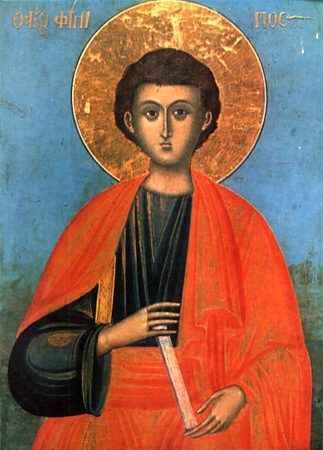
Philip was born in Bethsaida beside the Sea of Galilee, as were Peter and Andrew.
Instructed in Holy Scripture from his youth, Philip immediately responded to
the call of the Lord Jesus and followed Him (John 1:43). After the descent of
the Holy Spirit, Philip zealously preached the Gospel throughout many regions
in Asia and Greece. In Greece, the Jews wanted to kill him, but the Lord saved
him by His mighty miracles. Thus, a Jewish high priest that rushed at Philip
to beat him was suddenly blinded and turned completely black. Then there was
a great earthquake, and the earth opened up and swallowed Philip's wicked persecutor.
Many other miracles were manifested, especially the healing of the sick, by which
many pagans believed in Christ. In the Phrygian town of Hierapolis, St. Philip
found himself in common evangelical work with his sister Mariamna, St. John the
Theologian, and the Apostle Bartholomew. In this town there was a dangerous snake
that the pagans diligently fed and worshiped as a god. God's apostle killed the
snake through prayer as though with a spear, but he also incurred the wrath of
the unenlightened people. The wicked pagans seized Philip and crucified him upside-down
on a tree, and then crucified Bartholomew as well. At that, the earth opened
up and swallowed the judge and many other pagans with him. In great fear, the
people rushed to rescue the crucified apostles, but only Bartholomew was still
alive; Philip had already breathed his last. Bartholomew ordained Stachys as
bishop for those whom he and Philip had baptized. Stachys had been blind for
forty years, and Bartholomew and Philip had healed and baptized him. The relics
of St. Philip were later translated to Rome. This wonderful apostle suffered
in the year 86 in the time of Emperor Dometian.
St. Gregory Palamas, archbishop of Thessalonica (1360)
Commemorated on November 14/November 27
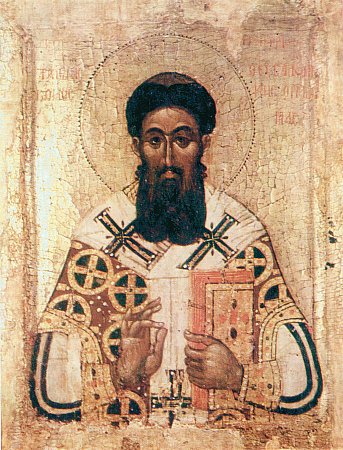
Gregory's father was an eminent official at the court of Emperor Andronicus II
Palaeologus. The gifted Gregory, completing his secular studies, did not want
to enter the service of the imperial court, but withdrew to the Holy Mountain
and was tonsured a monk. He lived a life of asceticism in the Monastery of Vatopedi
and the Great Lavra. He led the struggle against the heretic Barlaam and finally
defeated him. He was consecrated as Metropolitan of Thessalonica in the year
1347. He is glorified as an ascetic, a theologian, a hierarch and a miracle-worker.
The Most-holy Theotokos, St. John the Theologian, St. Demetrius, St. Anthony
the Great, St. John Chrysostom and angels of God appeared to him at different
times. He governed the Church in Thessalonica for thirteen years, of which he
spent one year in slavery under the Saracens in Asia. He entered peacefully into
rest in the year 1360, and took up his habitation in the Kingdom of Christ. His
relics repose in Thessalonica, where a beautiful church is dedicated to him.
St. Justinian the Emperor of Byzantium (565) and his wife St. Theodora (548)
Commemorated on November 14/November 27
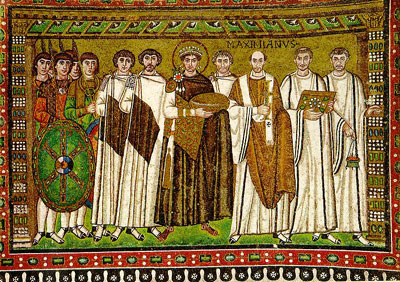
The Holy Right-Believing Emperor Justinian and Empress Theodora: Saint Justinian,
a major figure in the history of the Byzantine state, was also a great champion
of Orthodoxy, a builder of churches and a Church writer, and he was of Slavic
descent –born in Bulgaria. During his reign (527-565) Byzantium won glory
with military victories in Persia, Africa, Italy, –as a result of which
paganism was decisively rooted amongst the Germanic Vandal and West-Goth tribes.
By command of the emperor Justinian the pagan schools in Athens were closed.
With the aim of spreading Christianity through the regions of Asia Minor, Justinian
sent there the bishop of Ephesus John, who baptised more than 70 thousand pagans.
The emperor gave orders to build 90 churches for the newly‑converted, and
he generously supported church construction within the empire. His finest structures
of the time are considered to be the monastery at Sinai, and the church of Saint
Sophia at Constantinople. Under Saint Justinian many a church was built in the
name of our MostHoly Lady Mother of God. Being a man of quite diverse an education,
Saint Justinian assiduously concerned himself over the education of clergy and
monks, ordering them to be instructed in rhetorics, in philosophy and in theology.
The tight-believing sovereign devoted much attention and
effort into the struggle with the Origenists of his time, who then were reviving
the Nestorian heresy. Against their heretical speculations was composed the Church-hymn "Only-Begotten
Son and Immortal Word of God, Who for our salvation...", and he commanded
its singing as obligatory in the churches. From that time through the present
day this hymn is sung in the Divine Liturgy before the Small Entrance [i.e. 2nd
Antiphon]. At the command of the sovereign, in the year 553 was convened the
Fifth OEcumenical Council, censuring the teachings of Origen and affirming the
definitions of the Fourth Ecumenical Council at Chalcedon. The holy Emperor Justinian
about orderly rule and law within the realm. Under his guidance and supervision
was compiled a complete compendium of Roman laws, which has come down to us as
a codex of law known as "the Justinian Codex". The "Novellae" (i.e. "Church-laws")
of Justinian find inclusion in all the variants of the Russian Church-law NomoKanon
Books.
In his personal life, Saint Justinian was strictly pious,
and he zealously fasted quite often. The holy Emperor Justinian died in the year
565.
Together with the emperor was enumerated to the ranks of
the Saints his like‑minded spouse, the Empress Theodora, who died in the
year 548. She was at first a notorious sinner, and an adherent to the Monophysite
heresy, but then she repented and led a virtuous life, keeping purity of both
soul and body.
Holy Martyrs and Confessors Gurias (299), Samonas (306), and Abibus (322), of
Edessa
Commemorated on November 15/November 28
Gurias and Samonas were prominent citizens of Edessa. During one of the persecutions
of Christians, they hid outside the city and lived in fasting and prayer, encouraging
true believers who came to them for counsel. However, they were captured and
brought before the judge, who threatened them with death if they did not submit
to the imperial decree demanding idol worship. These holy martyrs of Christ answered
him: ``If we submit to the imperial decree, we will perish, even if you don't
kill us.'' After cruel torture, they were thrown into prison, where they remained
from August 1 to November 10, enduring hunger, darkness and pain. They were then
led out and again tortured, but since they remained unwavering in the Christian
Faith, they were condemned to death and beheaded in the year 322, during the
reign of the wicked Emperor Licinius. Later Abibus, a deacon in Edessa, suffered
tortures for Christ his Lord and gave his spirit to God while in the flames.
His mother took his body, miraculously intact, from the fire and buried it in
a grave with the relics of St. Gurias and St. Samonas. When the persecution ceased,
Christians built a church in honor of the three martyrs, Gurias, Samonas and
Abibus, and placed their miracle-working relics in a common reliquary. Of the
numerous miracles of these wonderful saints of God, the following is especially
outstanding: A widow in Edessa had a young daughter who was to marry a Gothic
soldier serving in the Greek army. As the mother feared for her daughter's safety
if she were to live far away, the Goth swore on the grave of the holy three martyrs
that he would do no evil to the maiden, but would take her as his lawful wife,
as he had already sworn that he was not already married. In reality, he did have
a wife, and when he took the young maiden to his country he kept her, not as
his wife but as a slave, until his lawful wife died. He then agreed with his
kinsmen to bury his living slave with his dead wife. The girl tearfully prayed
to the three holy martyrs to save her, and they appeared to her in the grave,
and took her in an instant from the land of the Goths to Edessa, to their church.
The following day when the church was opened, they found the young maiden by
the tomb of the saints of God, and learned of her miraculous deliverance.
Martyrs Elpidius, Marcellus, and Eustochius, who suffered under Julian the Apostate
(361)
Commemorated on November 15/November 28
The Holy Martyrs Elpidias, Marcellus and Evstochius suffered under the emperor
Julian the Apostate (361-363). Saint Elpidias was an important dignitary at the
imperial court. They tried him on charges of being a Christian, afront the imperial
judge. The martyrs endured many terrible torments and they died, thrown into
a fire. At the place where Christians buried the remains of the saints occurred
a miraculous appearance of Christ with an host of Angels, and the Lord resurrected
Elpidias. Then the emperor again gave orders to arrest the holy martyr. During
the time of torture, idols standing not afar off crumbled into dust through the
prayer of the saint. More than six thousand pagans, having witnessed this miracle,
were converted to Christ. Saint Elpidias was burned again.
"Kupyatich" Icon (1180) of the Most Holy Theotokos
Commemorated on November 15/November 28
The Kupyatitsk Icon of the Mother of God appeared in the year 1180 nearby the
village of Kupyatich in the area of the former Pinsk district of the Minsk governance.
The icon was found in the forest on a tree by the peasant maiden Anna, a cattle
herder. The image –in the form of a cross –shone with an unusual
light. On the spot of the miraculous appearance of the icon, peasants built a
church in the name of the MostHoly Mother of God, and placed the discovered icon
within it. After some years Tatars burned the church. The icon was found a second
time after many years by a chance traveller named Joachim. Peasants transferred
the cruciform-icon to the village church. Joachim remained at the church as church-attendant,
by God's will. At the beginning of the XVII Century next to the church was built
the Kupyatitsk monastery, which at the end of the century the Catholics seized
control of, and later on –Uniate monks. Orthodox monks in abandoning the
monastery took with them the holy icon of the Kupyatitsk Mother of God. They
transferred the wonderworking icon to the Kiev Sophia cathedral.
The Kupyatitsk Icon presents itself as a not-large copper
cross. On one side of the cross is depicted the Mother of God with the Praeternal
Infant, and on the other side –the Crucifixion.
Holy Apostle and Evangelist Matthew (60)
Commemorated on November 16/November 29
Matthew, son of Alphaeus, was a tax collector when the Lord saw him in Capernaum
and said: Follow Me. And he arose, and followed Him (Matthew 9:9). After that,
Matthew prepared a reception for the Lord in his home and thus provided the occasion
for the Lord to express several great truths about His coming to earth. After
receiving the Holy Spirit, Matthew preached the Gospel to the Parthians, Medes
and Ethiopians. In Ethiopia he appointed his follower Plato as bishop, and withdrew
to prayerful solitude on a mountain, where the Lord appeared to him. Matthew
baptized the wife and the son of the prince of Ethiopia, at which the prince
became greatly enraged and dispatched a guard to bring Matthew to him for trial.
The soldiers returned to the prince saying that they had heard Matthew's voice,
but could not see him with their eyes. The prince then sent a second guard. When
this guard approached the apostle, he shone with a heavenly light so powerful
that the soldiers could not look at him; filled with fear, they threw down their
weapons and returned. The prince then went himself. Matthew radiated such light
that the prince was instantly blinded. However, the holy apostle had a compassionate
heart; he prayed to God, and the prince was given back his sight. Unfortunately,
he saw only with physical eyes and not spiritual eyes. He arrested Matthew and
subjected him to cruel tortures. Twice, a large fire was lighted on his chest,
but the power of God preserved him alive and unharmed. Then the apostle prayed
to God and gave up his spirit. The prince commanded that the martyr's body be
placed in a lead coffin and thrown into the sea. The saint appeared to Bishop
Plato and told him where the coffin bearing his body could be found. The bishop
retrieved the coffin with Matthew's body from the sea. Witnessing this new miracle,
the prince was baptized and received the name Matthew. After that, the prince
left all the vanity of the world and became a presbyter and served the Church
in a God-pleasing way. When Plato died, the Apostle Matthew appeared to the presbyter
Matthew and counseled him to accept the episcopacy. He accepted the bishopric
and, for many years, was a good shepherd until the Lord called him to His Immortal
Kingdom. St. Matthew the Apostle wrote his Gospel in the Aramaic language. It
was soon after translated into Greek and the Greek text has come down to us,
while the Aramaic text has been lost. It is said of this evangelist that he never
ate meat, but only vegetables and fruit.
St. Fulvianus, prince of Ethiopia, in holy baptism Matthew (1st c.)
Commemorated on November 16/November 29
He handed over the Holy Apostle Matthew to fire, but seeing the miracles leading
to the death of the Holy Apostle, believed in Christ and zealously preached the
Christian faith. Later for his saintly life he became worthy of the rank of bishop.
He died in peace.
Hieromartyr Hipatius bishop of Gangra (360)
Commemorated on November 16/November 29
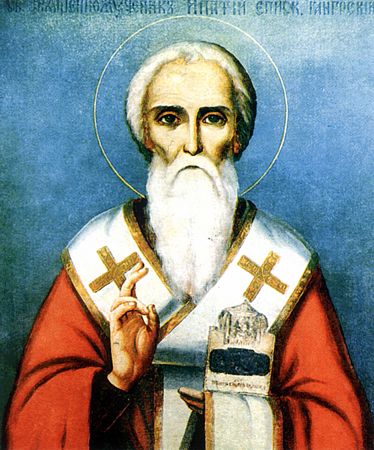
He was born in Cilicia in Asia Minor, and became Bishop of Gangra, the capital
of Paphlagonia. He took part in the First Ecumenical Council, where he was praised
by all for his piety and miracles. It is said that the Emperor Constantius kept
a bust of Hypatius in his palace as a weapon against demonic powers. The Saint
was murdered by the Novatians, a sect which believed that there is no forgiveness
for sins committed after Baptism. [The popularity of this belief helps to explain
why many believers at that time postponed baptism until very late in life.] As
Hypatius was traveling home from Constantinople, they attacked him on the road
and stoned him to death. A woman who took part in the attack went mad and began
to beat herself with a stone; she was only healed when her friends took her to
the grave of St Hypatius and prayed for her. Restored by his compassionate intercession,
she spent the rest of her life in repentance and prayer.
Venerable Sergius, abbot, of Malopinega (1585)
Commemorated on November 16/November 29
Sergius was a Russian parish priest who lived a God-pleasing life and served
for sixty-two years in the province of Vologda. He peacefully entered into rest
in the Lord on November 16, 1585, at the age of ninety-two.
St. Gregory the Wonderworker of Neo-Caesarea (266)
Commemorated on November 17/November 30
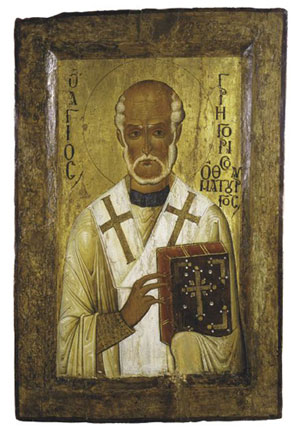
This man of God and powerful wonderworker was called a second Moses. Gregory
was born of pagan, but eminent and wealthy, parents. He studied Hellenic and
Egyptian philosophy and became aware of the meagerness and insufficiency of pagan
philosophy. He then turned to Christian teachers, particularly Origen of Alexandria,
with whom he studied for several years and from whom he received baptism. Pure
in body and soul, he wanted to dedicate himself solely to Christ God, for which
reason he withdrew to the wilderness, where he spent much time in rigorous asceticism.
His fame spread everywhere. Bishop Phaedimus of Amasea wanted to consecrate him
Bishop of Neocaesarea. The clairvoyant Gregory perceived Phaedimus's intention
and hid from the bishop's emissaries in the wilderness. Finally, Phaedimus consecrated
him in a strange way, and Gregory had to accept the office of bishop. The Most-holy
Theotokos and St. John the Theologian appeared to him in a vision, and St. John,
at the command of the Theotokos, gave him the Symbol of Faith that is known by
Gregory's name. Who can enumerate all the miracles of this second Moses? He had
power over evil spirits, and over mountains and waters, healed every pain and
infirmity, could become invisible to his persecutors, and clairvoyantly perceived
distant events and men's thoughts. He ended his earthly life in the year 270,
in great old age. When he arrived in Neocaesarea as bishop, he found only seventeen
Christians in that pagan city. When he departed this life, he left the city Christian,
with only seventeen pagans, and received the wreath of glory from his Lord in
the Heavenly Kingdom.
Venerable Nikon, abbot of Radonezh, disciple of St. Sergius (1426)
Commemorated on November 17/November 30
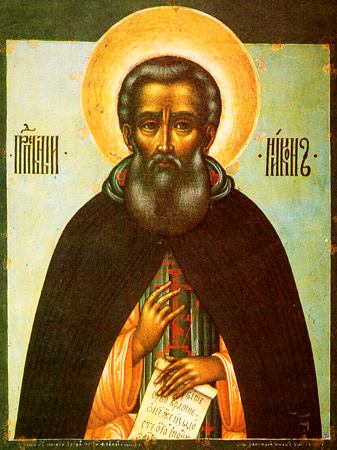
Nikon was a disciple of St. Sergius of Radonezh, and his successor as abbot.
When barbarians attacked Russia, Nikon prayed to God to remove this misfortune
from the Russian people. Then St. Sergius appeared to him with St. Peter and
St. Alexis (the reposed Metropolitans of Moscow) and told him not to grieve,
for the assault was by God's permission and was for their good, but would pass
and peace would reign once more. Nikon renovated the Monastery of the Holy Trinity
and served as an example to many of asceticism. He entered into rest on November
17, 1426.
Venerable Gennadius, abbot of Vatopedi, Mt. Athos (14th c.)
Commemorated on November 17/November 30
Gennadius was a monk of Vatopedi on Mount Athos, and had the obedience of being
steward. During his time as steward an empty barrel was miraculously filled with
oil. This miracle is ascribed to the Most-holy Theotokos, to whom the monastery
is dedicated, and especially to her icon, which was nearby.